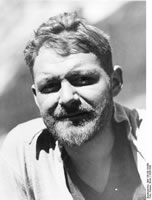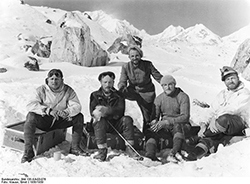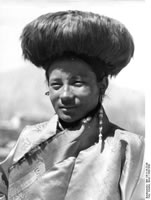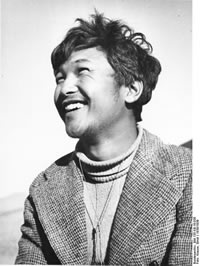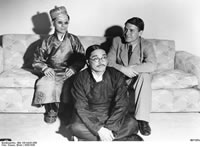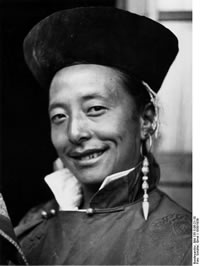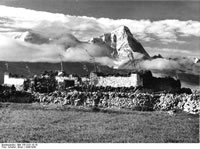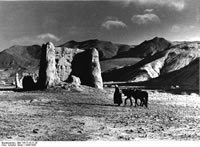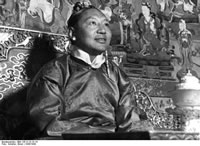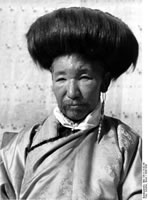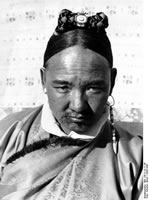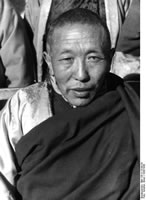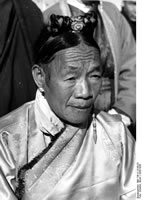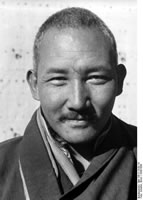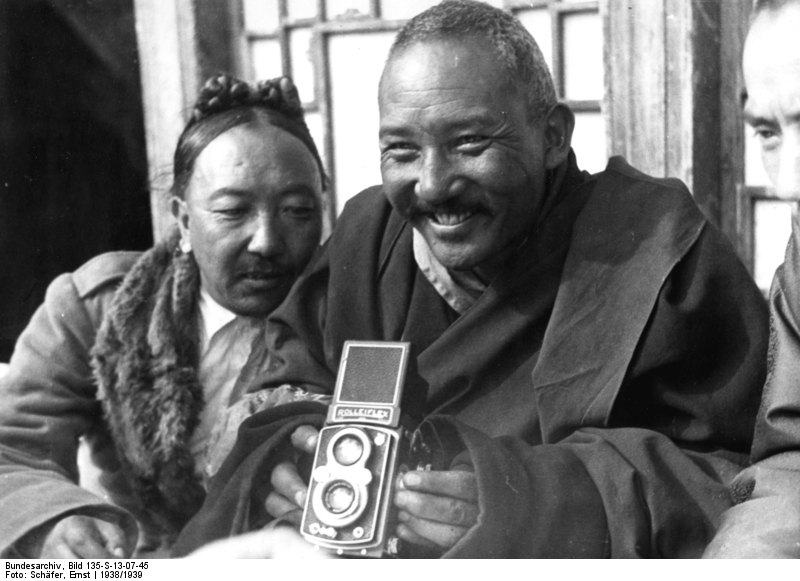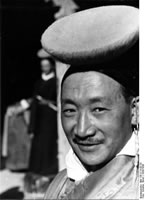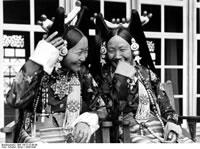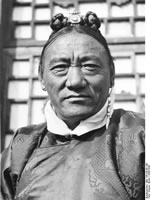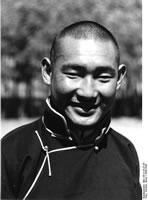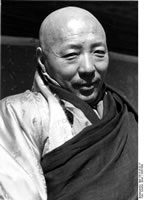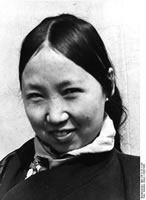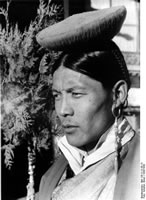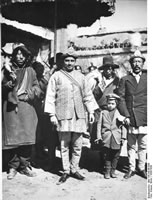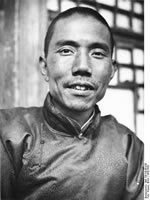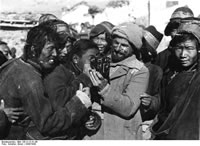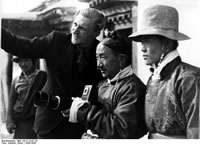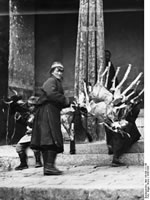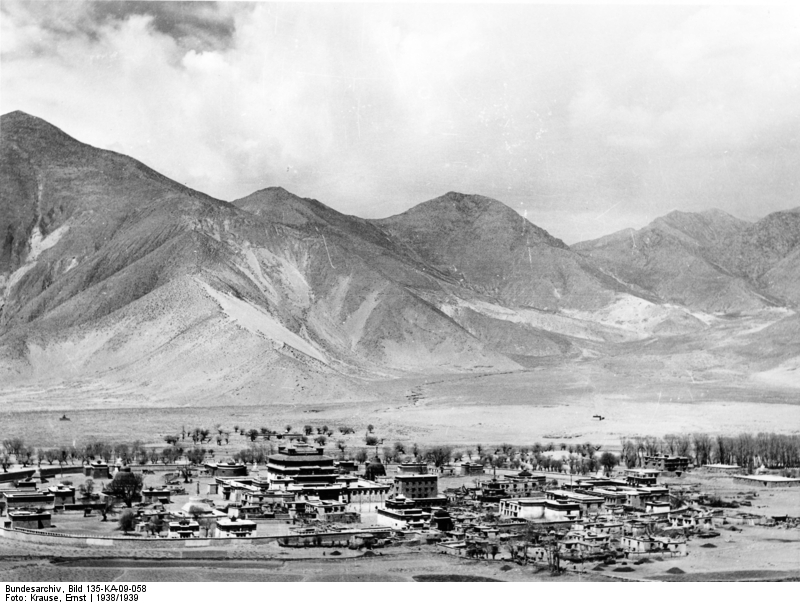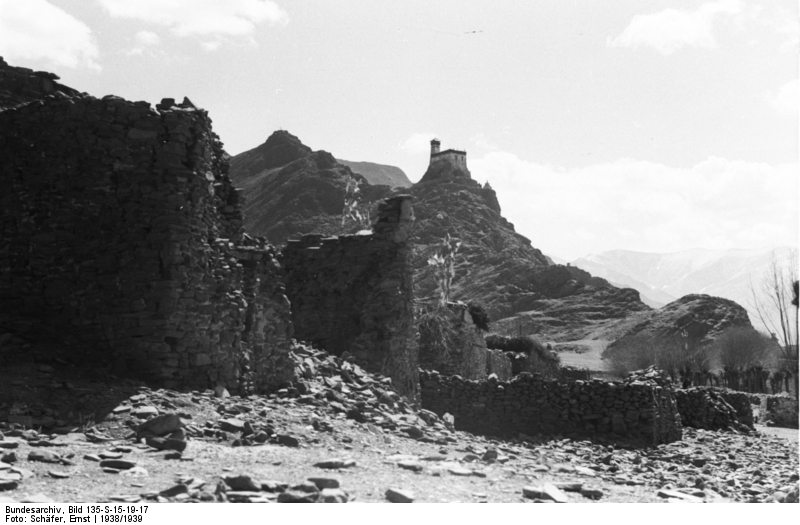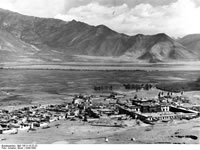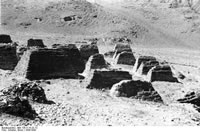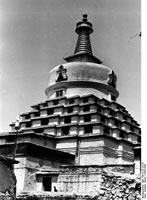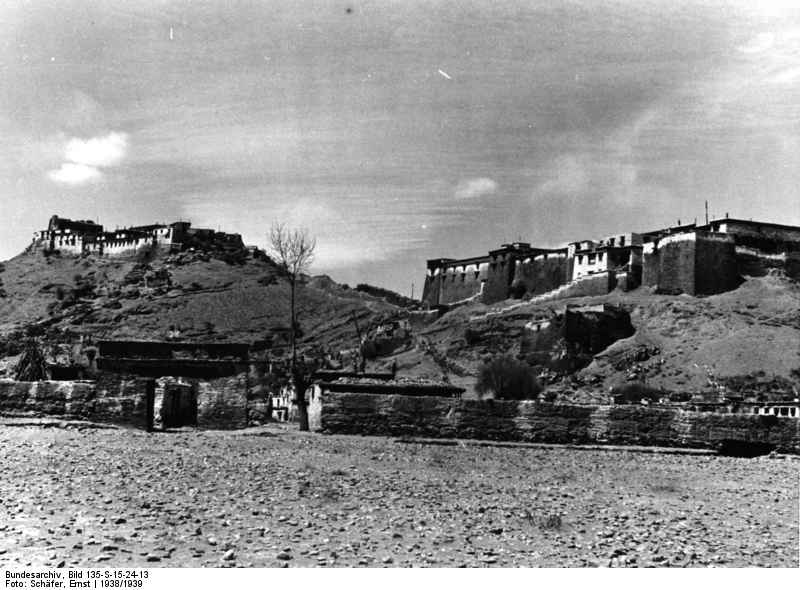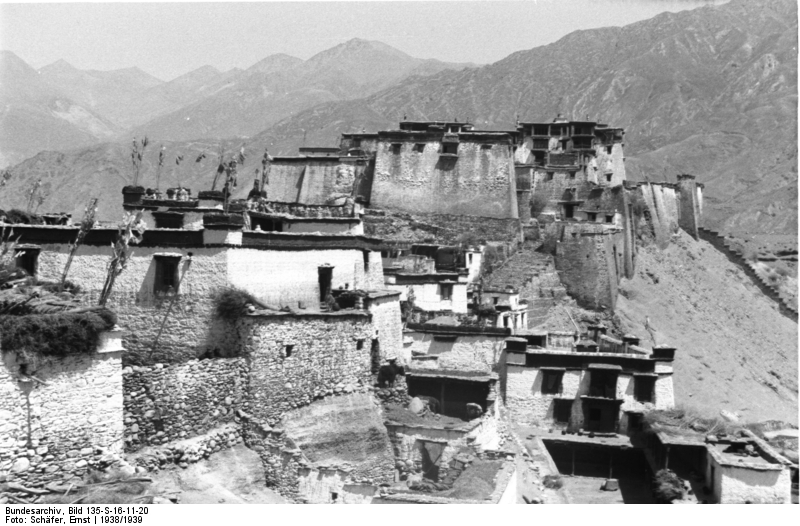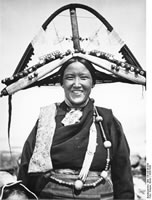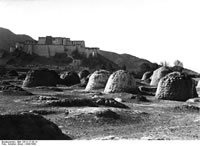Tibet in 1938–1939: The Ernst Schäfer Expedition to Tibet
by Isrun Engelhardt
Why post a paper on this website about an expedition to Tibet that happened over 70 years ago? What is so fascinating about this expedition? What is it that still triggers controversies? Again and again, Ernst Schäfer’s German expedition to Tibet has been the subject of sensationalist and ill-informed films, books, and articles on the internet. Many of these focus upon its alleged political objectives and secret occultism, a focus which has given rise to increasingly wild speculations.
For Tibet’s critics, this expedition serves as evidence of an alleged ‘Nazi-Tibet connection’, a supposed link which ultimately acts as a building block for the justification of Chinese annexation. Here, Isrun Engelhardt, one of the most knowledgeable researchers in the field, contextualises this and describes the background, progress and results of the expedition, thus clarifying many unjustified prejudices and half-truths.

The following paper by Isrun Engelhardt “Tibet in 1938–1939: The Ernst Schäfer Expedition to Tibet” is the “Introduction” to “Tibet in 1938-1939: Photographs from the Ernst Schäfer Expedition to Tibet”, edited by Isrun Engelhardt, Serinda Publications, 2007, pp. 11–61, 248–254, 258–260.
Table of Contents
- Methods and Sources
- Expedition Plans
- Concessions
- Expedition Members
- Start of the Expedition
- Native Expedition Member, Kaiser Bahadur Thapa
- Departure From Sikkim
- On the Road to Lhasa: Diary Entries and Photographs
- Encounters in Lhasa
- Meetings With Other Notables
- Tibetan Interest in Photography and Technology
- Losar and Mönlam
- Yarlung Valley
- Upstream from Tsethang
- Dzongs
- End of the Expedition and Return to Germany
- Points of Controversy
- Final Considerations – Reasons for the Expedition’s Success
- Notes
- Select Bibliography
High above the Rhine, the Federal Archives in Koblenz are home to a collection of 17,000 surviving negatives¹ out of an original 20,000. These photographs reveal a self-confident country, Tibet, or rather a self-confident people, the Tibetans, and are unique in that the members of this research expedition were interested in virtually every aspect of life in Tibet and Sikkim. Of great interest for Tibetan Buddhism and the Buddhist way of life – as we see in photos of monks, pilgrims, and religious festivals – these photos record a deep ethnological curiosity and thus provide a comprehensive picture of the daily lives of the people at that time. In contrast to many other photographers, the young Germans were also interested in the unspectacular – handicrafts, agriculture, and trade, among others subjects. Like other Europeans before them, they too were fascinated by nomadic peoples, most especially the Goloks of Eastern Tibet, who were visiting Lhasa on a pilgrimage during Losar, the Tibetan New Year. Also unique are a number of photographs of historic buildings and fortresses that no longer exist.
But why does this expedition continue to fascinate us today, and why does it still engender controversy? Most such discussions do not focus on the expedition’s actual – and important – scientific results. From a technical point of view, there was nothing singular or spectacular about the expedition, nothing to compare with the adventures of, say, Sven Hedin or Wilhelm Filchner. It involved little uncharted territory, explored few new routes, no expedition members were ambushed by predatory tribes, and no one was killed. Ernst Schäfer’s earlier expeditions to Eastern Tibet, in contrast, had involved considerably more adventure and excitement. Interest in this expedition no doubt derives from the period in which it occurred, shortly before the outbreak of World War II. This was the first German scientific expedition to receive an official invitation to Lhasa from the Tibetan government, and its members were ultimately allowed to stay in the Tibetan capital for a full two months. With the Tibetan government’s strict policy in the 1930s of refusing entry to foreigners, the invitation alone was a minor sensation, generating further tensions in the fraught and complex state of Anglo-German relations of the time.
Today the expedition has largely been forgotten, although its declared aim was to make scientific discoveries in several disciplines, primarily the natural sciences. Forgotten too are its members, who collected an astonishing quantity of scientific materials, some still awaiting analysis. Yet Germany’s most comprehensive collection of Tibetan ethnological objects, now at the Bavarian State Museum of Ethnology in Munich (Staatliches Museum für Völkerkunde München), came from the materials the Schäfer expedition collected. Because Schäfer’s books on this expedition have never been translated into English, public opinion in the English-speaking world has mainly been shaped by the sources available in the India Office Library in London, and by Hugh Richardson, who was in charge of the British Mission in Lhasa at the time of the expedition. This may account for the expedition’s dubious legacy in the English-speaking world, while in Germany today it has nearly been forgotten. Only in popular scientific literature and occult histories is the expedition cited repeatedly in recurring attempts to establish far-fetched connections between the Third Reich and Tibet, or occult relationships between Hitler and Tibet.² The majority of more recent publications also fall into this category, reflecting ideological preconceptions and sensationalism,³ with exceptions from Martin Brauen, Reinhard Greve, Nicholas Goodrick-Clarke, and in some ways James Cooper.⁴
Methods and Sources
In order to follow historical facts as closely as possible in my reconstruction of the expedition, I have drawn largely on unpublished sources as contemporaneous as possible, despite the four reports from the expedition that have been published so far.⁵ To create the most direct impressions possible, I have attempted to let the expedition members speak for themselves as often as possible through their unpublished notes, especially Schäfer’s diaries.⁶ The English records of the expedition’s Tibetan interpreter, Bhutia Rapten Kazi from Sikkim, were a lucky find. The previously unnoticed comments he wrote in Tibet about places, encounters, and events, such as Losar, also deserve to be published because his impressions and perspectives reflect more those of a local, rather than those of the expedition members. I have attempted to pursue primarily those themes that convey new and supplemental information. With the photographs, I have given preference to those that have not been published elsewhere, or that reveal motifs that other photographers have ignored. I have tried to give special attention to historical structures that have since been destroyed.
Expedition Plans
I first focus on the planning of the 1938-39 expedition and its objectives in order to show that it became ensnared in conflict between politics and science from the outset, even though it was planned as a purely scientific venture, more so than the earlier American expeditions in which Schäfer had participated. The ‘Ahnenerbe’ (German Ancestral Heritage Society)⁷ tried to influence and define the project from a political, esoteric, and pseudo-scientific viewpoint, while the need for official permits from the British entangled the expedition more deeply in foreign affairs. Here it becomes clear the extent to which German foreign policy, political alliances, and propaganda ultimately damaged the expedition’s goals and created enormous obstacles, although Britain’s political attention to, and fears about, the expedition were in inverse proportion to its size and scientific objectives.⁸
Ernst Schäfer, born in 1910, interrupted his university studies in zoology and geology twice. In 1930 Brooke Dolan, a rich young American, came to Germany to recruit scientists for a zoological expedition to Tibet he wanted to undertake. Although only 20 at the time, Schäfer participated in the first Dolan expedition to Western China and Eastern Tibet,⁹ before returning to Germany in 1932 to resume his studies.¹⁰ In 1934 Schäfer again interrupted his studies to head Dolan’s second expedition, this time to Eastern Tibet and China, sponsored again by the Academy of Natural Sciences in Philadelphia; this trip concluded in 1936.¹¹ The Academy acknowledged the great scientific success of both expeditions more than 50 years later in their 1992 obituary of Schäfer, which mentions that Schäfer and Dolan “collected scientic data and specimens of the region’s birds and mammals that have never been equaled in size and importance.¹² In recognition of his many scientific contributions Dr. Schafer was elected to life membership in the Academy [already] in 1932.”¹³ After his return to Germany, he resumed his studies in Berlin and in 1937, under Erwin Stresemann, completed his doctorate with a thesis, of unusually comprehensive scope for its time, on bird life in Tibet.¹⁴
At the time, Himmler was already trying to make use of Schäfer’s reputation for Nazi propaganda purposes. In June 1936 Himmler summoned Schäfer to ask about his future plans, and Schäfer told him that he wanted to lead another expedition to Tibet. Himmler had a genuine interest in Tibet¹⁵ as an adherent of a bizarre mixture of mystical and esoteric ideas.¹⁶ He believed in karma¹⁷ and reincarnation,¹⁸ ideas linked to his cyclical concept of history as recurring.¹⁹ “At this interview, Himmler said that he would like to facilitate Schäfer’s future plans for exploration, and that he would take over the sponsorship of Schäfer’s next expedition.”²⁰
Already in August 1936, Schäfer presented the German Research Foundation (DFG, or Deutsche Forschungsgemeinschaft) with a first detailed plan for an expedition to Eastern Tibet, which included archaeologists, ethnologists, geologists, and botanists.
“But the primary focus of the expedition was to be the Amnye Machen region, previously uncharted in every sense of the word. A region that contained the last completely undiscovered area of Central Asia from a geographical, but also an ethnological, botanical and faunistic viewpoint.”²¹
In Kant²² we can already find the ideas of Tibet being the point of origin and dissemination of many species and genera of plants and animals, being the key area in tribal history, being a refuge for a number of ancient life forms long extinct in other parts of the world, and of Asia being the cradle of mankind. At the start of the 20th century, Americans William Diller Matthew and Henry Fairfield Osborn had taken Kant’s ideas as the starting point for the development of their theories.²³ Schäfer himself closely aligned his goals for the expedition with the models and results of American researchers Roy Chapman Andrews and Gordon T. Bowles, and of an Australian missionary in Eastern Tibet, James H. Edgar.
Negotiations on issues such as financing dragged on until a memorandum from the ‘Ahnenerbe,’ dated August 1937, stated that Himmler wanted “the ‘Ahnenerbe’ to equip a new expedition to Tibet. The expedition is to be organized officially by the ‘Ahnenerbe’.”²⁴ The ‘Ahnenerbe’, which Himmler and others founded in Berlin in 1935, initially occupied itself with subjects such as early Germanic history, research into runes, the myth of Atlantis, and the World Ice Theory. However, the organization increasingly tried to gain a foothold in serious science, to extend its scope of study to include and focus on natural sciences, and to attract first-class scientists, so that their concerns extended towards both “serious” and “pseudo” science.
In addition, Himmler constantly tried to influence the work of the scientists so that they might turn their attention to new or unusual topics that interested him.²⁵ He was also interested in putting Schäfer’s work to use for his own pseudo-scientific purposes. Schäfer, however, was not interested in pseudo-science at all – he was completely devoted to natural science, and was steadfast in his refusal to allow Edmund Kiss,²⁶ a disciple of Hörbiger’s “World Ice Theory,”²⁷ to join the expedition.
Although Himmler eventually accepted Schäfer’s goals, a memorandum from September 1937 makes clear that the ‘Ahnenerbe’ continued to exert pressure on the issue of expedition membership, demanding that a geographer, anthropologist, geologist, botanist, representative of the World Ice Theory, and a prehistorian be included.²⁸
In December 1937 Schäfer submitted a final, detailed plan to the DFG in which he still assumed that the destination of the expedition would be Eastern Tibet, with access from China. This also included an anthropological program from anthropologist Bruno Beger,²⁹ whose program was based around the question of whether Indo-Europeans could be traced to Central Asia, an idea that had long been debated³⁰ far beyond National Socialist circles.³¹ Indeed, international and interdisciplinary discussion on this subject continues to this day.³²
Concessions
Although Schäfer was eventually able to free himself from Himmler’s meddling, and to assert his scientific freedom,³³ his objectives and those of Himmler and the ‘Ahnenerbe’ continued to diverge – so much so that Wolfram Sievers, head of the ‘Ahnenerbe’, declared in January 1938: “The task of the expedition in the meantime has diverged too far from the targets of Reichsfuehrer-SS [Himmler], and does not serve his ideas of cultural studies.” Sievers added in a later note, “[Himmler] complied with Dr. Schäfer’s request to be permitted to conduct negotiations himself concerning the expedition’s financing and organization. The ‘Ahnenerbe’ subsequently transferred the file to Dr. Schäfer.”³⁴ Eventually, at Himmler’s request, the ‘Ahnenerbe’ did not organize and carry through Schäfer’s expedition,³⁵ a decision in which financial factors no doubt also played a role.
In the end, neither Himmler nor the ‘Ahnenerbe’ directly sponsored the expedition, though Schäfer continued to receive political support from both. He was well aware of his dependence on Himmler and was forced to accept various compromises in order to maintain later the cooperation of the British in getting passports and especially in procuring foreign currency, the most difficult problem facing him at that time.³⁶ Himmler gave his consent to the expedition on the condition that all its members join the “SS”. Schäfer even had to compromise on the name and the letterhead of the expedition.³⁷ After his arrival in India, this letterhead caused Schäfer considerable difficulties with the British authorities. Even the German Consul-General in Calcutta (Kolkata) included an unusually pointed criticism in his report to the German Foreign Office, arguing that the prescribed letterhead was counter-productive and immediately generated mistrust among the British.³⁸
Schäfer continued his efforts to secure financing for the expedition to carry through his research objectives, and indeed did raise the funds for the expedition himself, albeit with the support of the ‘Ahnenerbe.’ He received 30,000 Reichsmark (RM) from the DFG.³⁹ A final statement from 15 November 1940 shows that the Public Relations and Advertising Council of German Business (Werberat der Deutschen Wirtschaft) bore the majority of the budget cost, with a contribution of RM 46,000. In return for sending in reports to two newspapers, the Völkischer Beobachter and the Illustrierter Beobachter, Eher Verlag – publishers of the papers – contributed another RM 20,000. The Foreign Office contributed RM 7,000 more, and finally RM 6,500 came from private donors, including Brooke Dolan.⁴⁰ The final bill of expenses totalled RM 112,111. Only the final leg of the hasty return flight from India, arranged at the looming outbreak of war, was financed by Himmler’s circle of friends.⁴¹
In the end, however, political conditions in East Asia compelled Schäfer to change his plans. After learning that there was no possibility of access through China, Schäfer had no choice but to attempt to reach Tibet through British India, where he would have to negotiate with the British authorities. Schäfer therefore left for London in March 1938 and there got an important letter of recommendation to Sir Aubrey Metcalfe, the British Foreign Minister in India. He also had a memorable and effective meeting with the aging Sir Francis Younghusband.⁴²
Expedition Members
The expedition comprised five members: Schäfer as mammologist and ornithologist; Ernst Krause, entomologist, as photographer and film camera operator; Karl Wienert, geophysicist; Edmund Geer, logistics and transport manager; and Bruno Beger, anthropologist, who was influenced by the racist anthropology that formed part of the Nazi ideology prevalent at the time. Yet what he actually did in Tibet, such as measuring skulls and making casts of people’s faces, was part of scientific practice at the time. The Schlagintweits had made casts as early as the mid-19th century, as had Gordon T. Bowles, an American anthropologist on the first Brooke Dolan Tibet expedition, for his doctorate at Harvard.⁴³ On Giotto Dainelli’s expedition to the Himalayas in 1930,⁴⁴ the anthropologist Renato Biasutti had also done so, as had many others.⁴⁵
Start of the Expedition
The expedition finally set out for Calcutta via Colombo in April 1938. Political controversy, stirred up by a German newspaper article published when the expedition left Germany,⁴⁶ caught up with them on their arrival and caused Schäfer enormous problems during negotiations with the British over entry permits for Sikkim and Tibet. In the meantime, the German Consul General had informed Schäfer of the Tibetan government’s refusal to let them enter,⁴⁷ which was consistent with that government’s customary behavior.⁴⁸ In meetings with Sir Aubrey Metcalfe and Viceroy Linlithgow in Simla, Schäfer initially succeeded in allaying British concerns. Lord Linlithgow⁴⁹ promised to give Schäfer permission to stay in Sikkim for six months,⁵⁰ and Sir Aubrey indicated his willingness to submit another application to the Tibetan government.
Schäfer’s second request for permission to enter Tibet was also fruitless. He continued exploring a variety of avenues, however, and finally some months later he and his crew were admitted to Lhasa, which was considered a great achievement in Germany.
How then did Schäfer manage to get permission to travel to Lhasa? In Gayokhang, North Sikkim he had a chance meeting with Gerpa Changla, Chief Steward of the Taring Raja and half-brother of the Maharaja of Sikkim, “who promised us to do his best with his important friends in Lhasa, Shigatse and Gyantse …”⁵¹ He also arranged for Schäfer to get an invitation from the Raja of Taring to visit the town of Doptra inside Tibet for several days.⁵² In accepting the invitation, Schäfer in a sense tricked the British by following the personal advice of Francis Younghusband “to sneak over the border.”⁵³
In Tibet he immediately established friendly contacts, and Taring promised to transfer Schäfer’s entry application directly to Lhasa. After returning to Gangtok, Schäfer drafted a flawless formal request to the Tibetan Regent Reting Rinpoche with the assistance of the private secretary of the Maharaja of Sikkim, two high-ranking Tibetan lamas, and a Tibetan doctor.⁵⁴ They also sent similar letters to the Prime Minister and the Kashag, and so began a long period of waiting. However, after a telegram from Hugh Richardson to Basil Gould,⁵⁵ Schäfer received through Gould an official letter of invitation with five seals from the Kashag, stating:
To the German Doctor Saheb Sha-phar:
Thank you for your letter of the 17th day of the 9th of the English month together with two boxes containing a gramophone, records and two pairs of binoculars.
Concerning you and the other Germans, Doctor Wienert, Mr. Krause, Mr. Beger, and Mr. Geer (altogether no more than five persons) who want to visit Lhasa and the holy Tibetan monasteries, please understand that no foreigners whatsoever are allowed to enter Tibet.
Although we know if we allow you to enter, others might come the next time, it nevertheless appears from your letter that you intend only friendship and to see the holy land and its religious institutions. Acknowledging this, we deign to give you permission to go to Lhasa and to stay there for two weeks, on condition that you oblige yourself not to harm the Tibetan people and consent to not hunt any birds or game, which would deeply hurt the feelings of the Tibetan people, both clergy and lay. Please kindly keep this in mind.
Sent from the Tibetan Kashag on the auspicious 3rd day of the 10th month of the earth-tiger year.⁵⁶
And so Schäfer finally had his “official leave,” albeit not from the British but directly from the Tibetan government. In the broader geopolitical context of the complicated relations between Britain and Tibet, this also demonstrated a certain independence on the part of Tibet from the British.
Schäfer considered this letter from the Kashag a minor miracle, as it was the first official invitation to a German mission to Tibet, where many of his predecessors, such as Wilhelm Filchner, had failed, although invitations to Lhasa had been granted to the American couple, Suydam Cutting⁵⁷ and his wife, and to Theos Bernard⁵⁸ the year before.
On 20 December the expedition finally set out for Yatung, Phari, Gyantse, and Lhasa by way of the usual route across the Nathu-la, arriving in Lhasa on 19 January 1939. At the recommendation of Gould and Richardson, Schäfer left Gangtok accompanied by Rapten Kazi, a master of Tibetan etiquette, to act as his advisor and interpreter for the expedition.⁵⁹ The members of the expedition did not take to him at first, and were distrustful because they suspected he was a spy planted by the British to keep an eye on them.⁶⁰ Over the course of the expedition, however, he became a committed member of the party.
Native Expedition Member, Kaiser Bahadur Thapa
According to Schäfer, the expedition “had a permanent native team of about ten men, including Sikkimese, Bhutias, Lepchas, Nepalese and Tibetans. They all were good, after I had dismissed the first bad ones. But one outstanding character was among them, our Nepalese interpreter Kaiser Bahadur Thapa, who owing to his faithfulness and ability was of the utmost help to the expedition and actually became my friend, as neither in China, Eastern Tibet nor any of these countries, have I ever found a man of such valuable qualities.”⁶¹
The young Gurkha in the dark blue suit had introduced himself in Gangtok, offering his services as an interpreter. He had attended secondary school there, he seemed clever and bright, and he spoke English well. He was in the service of the “Political Officers Work Department,” where he had received excellent training, but he was willing to quit in order to join the expedition, and for the spirit of adventure. Schäfer agreed to his demand for an unusually high salary because the project was in dire need of an interpreter. Beger writes,
There was a story behind his first name, Kaiser. When Kaiser was born, there was a constellation in the shape of a capital ‘K’ in the night sky and according to paternal tradition, the first name of the child had to start with that letter. This was at the end of the First World War, which had taken his father to France as a British mercenary. As a true warrior, his father held the German Kaiser in high regard so he gave his son the name of Kaiser. Unfortunately, this father died soon after, in 1924, so as the oldest and only son, Kaiser had to take care of his mother and three sisters now that he was grown. His earnings went to support the household.⁶²
Kaiser quickly became an indispensable advisor to Schäfer, and the others on the expedition also treated him as one of their own. Schäfer had him to thank – most especially his tact, his nerves, and his sensitivity – for much of the success of the expedition.⁶³ Oddly, his mastery of the Tibetan language did not seem quite sufficient in Lhasa.⁶⁴ Schäfer even wanted to take him back to Germany for advanced education but this was rejected with the reasonable argument that “Kaiser Bahadur Thapa is a Sikkim subject and was supported and educated by the Sikkim Durbar at their expense and at the same time the Durbar strongly object[s] to their subject being sent to the Foreign Country.”⁶⁵ And “the Durbar that had spent so much money and taken great interest for his education must have the primary claim to utilize his services.”⁶⁶ Another member from Sikkim should be mentioned, German Akay, who became the leader of the native members and hunter for the expedition. He was strong and tough, fond of women, and seems to have been rather wily. He died only recently, at age 90, in 2005.⁶⁷
Departure From Sikkim
In Gangtok, Schäfer met with the Maharaja of Sikkim, Tashi Namgyal, and his private secretary, Rai Sahib Tashi Damdul. In the official photograph of their visit, as private secretary he was not allowed to sit on the couch, on the same level with the others, despite Schäfer’s insistent requests, but had to sit on the floor.
Schäfer summarizes the results of six months of research in Northern Sikkim in a report for the Indian press in December 1938. The English is his:
The German Scientific Party (Schafer Expedition) under the leadership of Dr. E. Schafer has after a six months’ thorough study now completed the expedition work in Sikkim where permission was kindly granted by his Highness the Maharajah of Sikkim and B.J. Gould, the Political Officer in Sikkim …
The expedition might be called an all-round natural history expedition comprising studies of terrestrial magnetism, ethnology, anthropology, ornithology, mammology and partly botany and of course geography, besides of taking moving pictures of wild life, and the magnification of nature of the Himalayas and the adjacent countries … The Germans think that the co-operation of closely related branches of sciences and especially of evolutionary and biological studies has to be fostered …
Sikkim, though it is only a very small country, has, due to its geographical position, the greatest advantage of being a country of not less than five entirely, different biological zones and it is a country of the greatest climatical changes imaginable. Ranging from the semi-arctic condition which prevail on the Tibetan steppes north of the snow-covered main range of the Himalayas through palae-arctic, temperate, sub-tropical to purely tropical areas such as the fever invested Terai. Therefore it is a country par excellence to study not only problems of adaptation of climate and altitude but also of development of races and species with human beings as well as animals and plants.
Herr Beger’s work as anthropologist and ethnologist confined itself to the studies of the very interesting human races found in a great number in Sikkim such as Bhutias, Lepchas, Tibetans, Nepalis, Hindus, and the most interesting mountain people from Lachung and Lachen who in different valleys have developed not only their different cultures but also seem racially to be very distinct bodies of highly civilised traders and agriculturists, it was most astonishing that with the change of the anthropological aspects in the different zones there was also a great parallelism observed within the different races and species of animals and birds. Nature having had the same effect or at least the same tendency of development with all living beings in space of time.
Here the anthropo-geographer’s problem clearly touch those of the biologists: Dr. Schafer as a mammologist and ornithologist and Mr. Krause as entomologist. The party was specially successful in discovering a big game animal unknown from Sikkim and as far as evidence shows to the present day, also entirely unknown to science. Beginning in the eastern Himalayas and even in the spurs of the Himalayas on the western China border and stretching far westwards along the axis of the Himalayas the most interesting biological zone is to be found in the sub-tropical parts at altitudes between 7,000 and 12,000 feet where most of the endemic species and so-called living fossils can be found. There are species of animals and plants which have survived as relicts forms from the late Tertiary, the Miocene and Pliocene many million years ago, in fact they are the most primitive forms, known to science such as the Giant Panda of western China and the Takin of Szetschwan, Mishmi and Bhutan, the westernmost boundary of the latter ani mals having been found near Lachung in north eastern Sikkim.
In this very same highly interesting climatic zone however the expedition was able to secure the above-mentioned new animals called the ‘Schapi’ by the Lepchas being related to the goats family and to the western Himalayan Thar but having been blocked in its distribution by the high snow-covered ranges of Kanchenjunga and therefore being restricted only to a very small area. There were only 4 or 5 Lepchas existing who have heard about this strange animal which was otherwise unknown to the entire population of Sikkim. Of course most of the scientific researches have to carefully worked over when the expedition is finished.⁶⁸
We can also hear from Beger, who describes the mayoral system he found:
In Lachen and Lachung the person named to head the village, the Pipön, was replaced every three years. In both villages, the head of the village had been chosen for many years from the richest, most respected and certainly the most talented clan.⁶⁹ For some time now the young Namgyal Pipon had been the head of the village.
On the Road to Lhasa: Diary Entries and Photographs
At the Tibetan border crossing at Nathu-la, to everyone’s astonishment there were neither guards nor soldiers, no barriers or gates. Only a ladze surrounded by prayer flags and an old cairn erected years previously at the top of the pass marked the border between the two countries. On 27 December 1938, the expedition reached Phari Dzong, the southernmost town of Tibet’s southernmost dzong (administrative district). As such, and as a stop on the route for large caravans, Phari was an important market town of 700-800 people.⁷⁰ Beger writes:
In Phari Dzong most of the houses were no higher than 2.5 or 3 meters, most likely due to the loosely packed ground, and they were generally constructed of peat. The construction material was dug up from the bogs surrounding Phari Dzong in the shape of bricks, but larger than ours.⁷¹
In the next village, Tuna, they had a fantastic view of the holy mountain Jomolhari.
Under the influence of Political Officer Charles Bell, the caravan road between Phari Dzong and Gyantse on the way to Lhasa has been so well reinforced that you could drive a car on it if the Tibetans would allow it.⁷²
The 5–6 kilometer stretch from Khangmar, south of Samada, to about Saphügang, just before Gyantse, proved to be unusually rich in ruins. Beger counted a total of 60 rather large-scale and impressive ruins. He tried to find out why there were so many, but questioning local Tibetans led to no satisfactory explanation. To Beger and Schäfer, it looked as if the countryside had once been a more thriving and more densely populated place. They wanted to know whether a greater population density would still be possible today and whether the land could support it. They hypothesized that there had once been much more rain and richer vegetation, and that some of what were now ruins had been deserted simply because of drought, turning to ruins the structures whose style suggests they were built in the same era. Several factors were likely involved, so that droughts, epidemics, or wars caused the demise of these villages. Rai Bahadur Döndup, for example, attributed the demise of the population to a shortage of water.⁷³
In Gyantse, with a population of 4,000–5,000,⁷⁴ the travelers had friendly contact with the ambitious head of the western dzong, Dzongpön Coktray, a good friend of the Reting Regent, and his wife Namgyal Tshedrön, who charmed all the members of the expedition.
The interpreter Rapten reported the following impressions in English:
Conversation with Dzong Choktray and his wife Cham Kusho:
Kungo and Cham Kusho invited all the Sahibs to lunch by sending their ponies. The Kungo and Cham Kusho received the gentlemen at their courtyard and were taken in to their altar place. All the gentlemen were served with Chinese food. One of the dishes was hot and Dr. Wienert unknowingly tasted it – he generally takes no hot things. Mrs. Dzong said that the other day Dr. Wienert [had] paid no visit to their place that is why she punished him by giving him that hot things. Mrs. Dzong played … the host in distributing the different dishes to all the gentlemen. But she always put more things in the dish of Doctor-Sahib and occasionally got up and went to sit with him. She said that she likes a gentleman who has hair like gold and eyes like turquoise …⁷⁵
The Dzongpön went on [to say] that they would meet the Kashag ministers and Taring Kumar and Tsarong Dzasa (who will be very glad to see us) and not to speak from [of] the Regent. He said that if the Regent is pleased, he will allow the Sahibs to take his photo, otherwise not. In any case the Dzong says that it is not the rule to disallow a visitor to stay for more than 15 minutes with the Regent. He also says that the Regent is a young reincarnated Lama, who has a great interest in photography.⁷⁶
In comparison with these visits, the encounter between members of the expedition and the young spiritual leader of Gyantse seems to have taken a much more formal course:
Interview with Labrang Kungo, the monastic head of Gyantse:⁷⁷
Through a servant of the Kungo we sent word of our visit. Instantly the Lama appeared at the door of his house, saluted to Dr. Schafer and Dr. Beger and shook hands. He said Tashi Dilay which means “so [it] is,” like the English “How do you do.” The Lama asked whether the Sahibs would like to have some Tibetan tea and it was served. The Lama said it is the first German visit to Tibet and requested Dr. Schafer to keep a long … good-will between Tibet and Germany. He regretted very much for not being able to give any reception to the Sahibs. However, he said that he wished to see all the Sahibs in health on their return from Lhasa. He said the Sahibs will have a very pleasant journey and favourable weather except at Karoo-La, where they will feel a bit cold. He said that the sahibs will spend the days very nicely at Lhasa as the weather is warm there. The lama said that the German swastika is the lasting unchangeable sign, which always turns from the left to the right. He also said that the new incarnation of Dalai Lama is believed to have been born at Amdo and although the tracing of the New Dalai Lama is not yet finished, yet the young Dalai Lama will … be brought to Lhasa within this year.
He said that the present Regent is the reincarnated Lama of Reting during whose birth many wonderful signs appeared. He was requested [to serve] as a regent till Dalai Lama’s rebirth by all the religious and lay men of Tibet. Then this conversation ended and the Lama requested the Sahibs [take] care very good about their health and returned the scarf a sign of meeting again.⁷⁸
The day before their arrival in Lhasa the expedition encountered a pilgrim who performed a ritual of traveling along the road by kyangchak, or body-length prostrations.
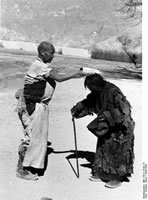
Near Lhasa. A pilgrim who measures the road with full body-length prostrations, stops to bless a woman.
BA: 135-S-15-02-13
We met a devout man from Amdo sitting on the edge of the road praying. He had a thick gray leather apron wrapped around him and gloves with a wooden surface on the hands. We had already heard about this kind of pilgrimage. He measured his path by the length of his body, throwing himself down to do so, then drawing a line above his head, raising himself up, moving forward to the line, and starting over again, saying a long prayer as he did so. And as soon as that was finished, he took a short break to recover. This pilgrim was only 26 years old and had been traveling through the country in this manner for seven years, covering about six kilometers a day, which he conscientiously measured by the length of his body. This pilgrim’s acts were considered very holy in Tibet. And every Tibetan who met such a holy man contributed money and food to him. A woman coming down the road was blessed by him. In giving his blessing, he placed his wood-gloved hand on her head and said a short prayer. In accordance with their vow, these pilgrims always had to stay overnight in the next-closest village and begin the following day wherever they had quit the day before. The pilgrim, who we watched for some time, interrupted his journey as twilight approached. With raised hands, he said a long prayer. The next day he would return to this spot and continue his pilgrimage. He wanted to be in Lhasa in five or six days.⁷⁹
Encounters in Lhasa
While in Lhasa, Schäfer successfully extended the mission’s stay several times, so that they were able to stay a full two months in the city instead of two weeks, as the permit had previously specified. Soon after their arrival, they began their official visits to members of the Kashag and in some cases developed friendly relations with them. The following are a few personal impressions.
What expedition members liked most about the young 29-year-old Silön (or “Prime Minister”) Yapzhi Langdün, nephew of the 13th Dalai Lama, was his richly furnished house.⁸⁰
The Senior Shape, Langchunga, was the most conservative of the Shapes. “The old Shape is completely opposed to modern doings. Like an old lion, he got his back up about installing electric lights and to this day his house is still bathed in the light of butter lamps.”⁸¹ But during their stay in Lhasa this apparently changed because the next time they visited, Schäfer was told, “Now he has already bought the light machines and he said they have been installed, although he himself is strongly opposed and doesn’t want anything to do with it. ‘Look,’ he said, looking at the ceiling, ‘Now I have electricity; I’m an old man and stick to the old ways. New things only bring misfortune.’ Although he was the most important of all the Shapes, he was also the most modest and lived more simply than anyone. As always, our political discussion is very guarded.”⁸²
Schäfer’s only comment about Böndong was that he was the richest minister, who had risen from modest family circumstances.⁸³
Kalön Lama, the Shape Trekhang, was an uncle of the Phalha brothers and, in the view of expedition members, the most open and interesting of the ministers.⁸⁴ Schäfer was touched by their meeting and very pleased that Kalön Lama even gave them a letter of recommendation to the supervisor of his estate in Yarlung.⁸⁵
Friendly relations developed with Yapzhi Phünkhang, the recently appointed Shape from the family of the 11th Dalai Lama,⁸⁶ and his family, with whom they were very much taken. Later his two sons even wanted to come to Germany. “His wife also cut a good figure, enveloped in a festive decoration, a patruk. Fake hair wrapped around a triangular frame on her head, bedecked with pearls on top of pearls, jade, turquoise, and agate, the riches of the Nagas. Then rose quartz, smoky quartz, and coral valued at about 50,000 rupees” [plates 01–02].⁸⁷ They were also particularly taken with their 17-year-old daughter, who was a nun. [plate 03]
Concerning the Reting Rinpoche [plates 04-06], Schäfer in his diaries gives us a lively and detailed account of his meetings with the regent. He tells us that although requests for an audience had by rule to be submitted at least three days in advance – even the Prime Minister was forced to wait a long time – Schäfer himself was soon able to have an audience with the regent whenever he liked. Schäfer once even met with him for over three hours. During the audiences, the regent would sit on his throne with his favorite dog. A young boy, the son of the new Kashag minister and described as his “favorite,” was also always present. Reting wore a yellow suede coat and had several German and two golden Belgian pistols hanging above him on the wall. According to Schäfer he knew little about the outside world, although he was interested in modern technology.
Schäfer at first appeared to be impressed with the personality of the regent, his contemporary in age. Schäfer invited him to Germany and they seriously discussed plans for the journey, as several other aristocratic young men also wanted to travel there. Reting wanted to be picked up by a German plane in Calcutta and flown to Germany,⁸⁸ but apparently the Kashag would not consent to the trip. Gradually, however, Schäfer’s initial impression became increasingly negative, as Reting Rinpoche apparently always tried to get some personal benefit from their relationship.⁸⁹
Reting must have also been very fond of Bruno Beger, whom he wanted to engage as a bodyguard. Beger had some difficulty extracting himself from this situation without offending the regent. Reting suggested that Beger stay in Tibet⁹⁰ and that a geshe, a particularly learned monk, go to Germany in exchange to introduce Buddhism there.⁹¹ This may have been the first official attempt by Tibetans to spread Buddhism to Europe. Schäfer apparently persuaded the regent to write a polite and non-committal letter to Hitler, although he seemingly had little idea of who Hitler was. Schäfer had probably given the impression that he carried far more political weight than he did, and presumably wanted additional proof of his success in Tibet.⁹²
The expedition’s most valuable informant, however, with whom members met almost every day, was Möndro, a high monk-official who had been one of the four “Rugby Boys” sent to school in England in 1913. Möndro was responsible for the police force in Lhasa, but he had been demoted from the Fourth to the Sixth Rank after his motorcycle, the first in Tibet, caused the horse of a Kashag minister to throw him.⁹³ He was forbidden to use the motorcycle anymore, but was an endearing personality who thoroughly enjoyed life. Even though he had returned to Tibet over 20 years previously, he still spoke good English.”⁹⁴ When the expedition departed Lhasa by way of the Yarlung Valley on the way to Shigatse, Möndro was assigned as official escort, although this was certainly also to keep an eye on them for the Kashag.
The maitre de plaisir, escort commander, guide, and protector is K.K. Möndro, a high Tibetan officer (higher than a general, directly under the ministers). He speaks English, he was assigned to us by the Regent, who is very friendly towards Germany, he has long been our best friend, and he is responsible to the government for our well-being and the receptions. He does everything I want and arranges everything perfectly. The messengers are always two days ahead of us so I can truly say that we are treated royally. Given Möndro’s outstanding organization of the caravan on the one hand, and his advanced education and absolute tolerance on the other, we enjoy the most pleasant scientific⁹⁵ work imaginable.⁹⁶
The members of the expedition also appreciated his sense of humor and repeated pranks, as the following vignettes illustrate:
Möndro imitates Barasahib [i.e. Schäfer]: Ang Bao, Beger’s servant, was supposed to carry five small ruddy shelducks to Penam in Schäfer’s cap. But one of them escaped along the way so the hunt was on. We watched in amusement. Then Möndro said to me, ‘If Schäfer were here now, he would be yelling,’ and then he started yelling himself, ‘He spoils all my birds, this fool!’ As he yelled, he tried to imitate Barasahib’s facial expressions, his speech, and tone, and he was quite pleased with himself.⁹⁷
And again:
In a monastery in Tsethang, the lama there attempted to show a relic in the gloom and everyone stared without being able to see anything. Möndro was also watching curiously for a long time. Finally we asked him what it was. Then he answered with that unique and charming laugh of his, ‘Nothing, but it’s very interesting.’⁹⁸
Friendly relations also developed with the other two surviving “Rugby Boys,” Ringang and Kyibu, and the two came and went in their guesthouse, which the Kashag had provided for them. Kyibu Wangdü Norbu turned out to be a well-informed connoisseur of classical German music.⁹⁹
Friendship ensued with the family of Ringang, youngest of the four “Rugby Boys.” He was the most intelligent of them, and stayed in England until 1924 to study engineering. He was in charge of the hydro-electric power station in Lhasa and also became the official translator for the Tibetan government.
He is the most conservative and the most progressive in one. He retains his Buddhism, although he spent thirteen years in England and left at thirteen years of age. He gets up at 4 AM every morning and circumambulates the Tsuklakhang after the sun has risen. Today Ringang is not only in charge of electricity, he’s also interpreter, code developer, English advisor, and a kind of foreign minister.¹⁰⁰
The expedition made contact with many aristocratic families as well. The person who fascinated them the most – as he did all foreigners – was Dzasa Tsarong, whom they considered the most outstanding and only true politician in Tibet. They even had their Tibetan interpreter write a short autobiography of him¹⁰¹ after interviewing him for that purpose.¹⁰²
Bruno Beger, the expedition’s anthropologist, had a particularly positive influence on the expeditions relations with the Tibetans because he had some medical training that enabled him to treat members of the Tibetan aristocracy effectively.¹⁰³ Beger, who had not sought this kind of work, was chagrined to find that his success generated envy among the local English, who regarded him as a source of competition.¹⁰⁴ Every morning people queued up in front of the government guesthouse where Schäfer and the other men were staying and waited until Beger was awake. Over and over again he complained that his days in Lhasa were almost completely occupied with this medical work¹⁰⁵ and that he was so overrun with Tibetan patients that he was hardly able to do any ethnological work.¹⁰⁶ So it came about that expedition members were frequently invited into the houses of the nobility:
The Tibetans had something on their minds. Most of all they asked about our German medicine, which they believed was the best in the world. And in the opinion of Tibetans, German doctors have supernatural powers. Since I was not a specialist, I always took great care not to endanger this good reputation. We repeatedly told the ministers and the Regent how good it would be to send intelligent young Tibetans to Germany to study medicine. We also promised to send them a lot of good medicinal products when we were back in Germany.¹⁰⁷
In his diary, Schäfer also remarks on the good reputation that German medicine had:
Today on February 24 the … Dzongpön on the Nepal border asked whether we had invented medicine that could completely prevent death since we had invented the greatest war machines. When I had to say no, he was visibly disappointed, but his respect for us rose once again when I explained to him about cardiac operations that had already succeeded, even when the heart muscle was damaged [by gunshot].¹⁰⁸
The expedition members were also frequent guests of the Phalha family. “The three brothers were kindness itself, and two are real lamas who neither smoke nor drink. This is a very rich family that owns three houses, including one in Gyantse where they also maintain a large carpet factory that employs 40 workers. Some of the dyes were Tibetan and some came from India.”¹⁰⁹ Beger quickly made friends with Tashi Wanchuk Phalha.¹¹⁰
One day the expedition had an opportunity to admire and photograph a servant in a wonderful old festive costume and expensive mutik thugkhok, a kind of pearl coif, which was so elaborate that it prevented her from walking.¹¹¹ Beger was asked to treat the mother of the Phalha family, who was seriously ill. Even when his arts did not help, he was still presented with rich gifts. In return for his medical treatment, the family went so far as to give the expedition a complete copy of the Lhasa Kanjur, which required nine mules to carry.¹¹²
Meetings With Other Notables
After visiting the Nechung Oracle, Ta Lama Lobsang Namgyal, Schäfer observed:
He gave the impression of being a fine, distinguished person, he was even born in Drepung and, despite his forty-six years, had known very little [about the world] until he became the oracle. Four years earlier, his predecessor in office had died and although he had been a completely normal person and not at all epileptic, he became Rinpoche of a Tendzin incarnation, assuming the spirit of Nechung. He eagerly provided information about everything to me.
He impressed Schäfer as the most intelligent and mentally alert and among the best informed about foreign policy, and had his own opinions not only about China, Japan, Russia, and India, but also about Europe.¹¹³ This was all the more surprising considering his background.
Tendzin Dölkar, wife of former minister Dorje Tshegyal Lungshar and daughter of the deceased Horkhang Dzasa, came to visit the expedition shortly before the end of their time in Lhasa. She brought several gifts particularly valuable for their ethnological collection but also asked them to visit her mother and herself for medical treatment. Beger had absolutely no desire to play doctor anymore, but could not refuse her request:
Despite the fact that she was forty-three, she was still an attractive woman. The little broken English she knew sounded simply enchanting coming out of her mouth. Besides that, she was the first Tibetan woman who had left the country through India. Twenty-five years ago she had traveled to England with her husband and had even visited Germany along the way.¹¹⁴
Beger thus visited her and her seventy year-old mother on 16 March 1939, accompanied by Ang Bao:
Her stomach and intestinal complaints, she repeated several times, were undoubtedly connected to her state of mind and a great deal of sorrow and grief. I inquired further but on that day I couldn’t learn any more from her. Something remained incomprehensible to me. This woman certainly had a secret to hide. On March 18, the day before our departure, she visited us once again. We found her exceptionally pleasant, just as before. Since Möndro was present, we learned somewhat more about her and the fate of her family this time.
When the Dalai Lama was still alive, her husband had been one of the most respected and powerful men in Tibet. There were two political parties in Tibet at the time, the leader of the stronger one was Lungshar and that of the opposing party was Tsipön Kapshöpa. After the Dalai Lama’s death, the tide turned, however. The weaker party now won state power. It was during this time that Mrs. Lungshar had a bad dream that led her to advise her husband to flee to India. But it was too late. He was arrested that same day and they fixed him for life in a horrible manner. They put two toggles on his temple and, using a cord thrown over his head, they pulled them tighter and tighter until his eyes bulged out. They cut out his eyes and poured boiling oil in the empty sockets. Then they locked him up for two years.
The Lungshar family is still very rich and respected. The oldest son was adopted by another family. He is one of the young, and certainly one of the greatest revolutionaries in Tibet. The disgrace suffered by his father is indelibly burned into his heart. His hatred and that of the Lungshar family is directed at the Tsipön of Lhasa, who gave the order to arrest, torture, and imprison his father. Even without knowing this story, I too found the Tsipön family to be one of the most disagreeable in all of Lhasa.¹¹⁵
The blind Mr. Lungshar now lives quietly on an estate near Lhasa. He wants very much to emigrate with his family to India (Darjeeling) or another neighboring country but he is under constant surveillance, making escape impossible. With admirable courage and strength of character, his wife had held together the family and the sizeable family property all those years. Now she is almost at the end of her strength. Soon she wanted to follow her mother into the convent.¹¹⁶
Before meeting Mrs. Lungshar, her oldest son Lhalu had invited the members of the expedition to a feast after the archery contest at the dzonggyap (literally, “behind the fort”) festival grounds north of Lhasa on the third day of the New Year. Despite being only 20, Lhalu had already reached the Fourth Rank¹¹⁷ and was one of the best marksmen.
[He] turned out to be not just a great guy among the youth but also a friend and a revolutionary who said all sorts of things to get a conversation going with us. He was still young so he was not yet very high placed but he wanted to get ahead, he said, and most of the young royalty thought like he did. Tibet had to develop, they wanted to attend college, make something of themselves, and change the tide in their country.¹¹⁸
Jigme Taring, the current treasurer, Labrang or Lachag, seemed to Schäfer to be quite different from any other Tibetan, since he had been raised in an English manner and “represented a truly aristocratic figure” in his eyes.¹¹⁹ Weeks before the Mönlam festival, he was already extremely busy because, as Labrang, he was responsible for the food for 30,000 lamas.¹²⁰ During Mönlam, the expedition watched as he stood on a high pedestal and had money handed out to the monks, who pressed forward in a single line to receive one copper coin each.¹²¹
Schäfer also contacted representatives from China and Nepal, who had sent delegates to greet the expedition outside Lhasa. From the start he got along especially well with Nepal’s representative, Major Hiranya Bahadur Bista. “The Nepali, Major Bista, came to us with half a regiment of red Gurkhas under a parasol and in full regalia, a splendid man who really wants to help us with Nepal.”¹²² This was a promise he would keep many times over.
Soon after their arrival, the expedition was invited to a banquet in their honor at the Chinese mission, together with Chang Wei-pei (Zhang Weibai), Tsarong, Möndro, and Pangdatshang.
The Chinese representative’s house was in the middle of the city, on the main street that went around the Tsuklakhang Temple, about 200 meters south of its entrance. The Chinese national flag waved from the roof of the building; it was raised every morning while the Chinese national anthem was sung and taken down every evening with the solemn earnestness of the New China. The building is genuine Tibetan. In the living quarters of Chang, the Chinese representative, however, the spirit of new China was apparent. Pride of place in the visitor’s room went to the portrait of Chiang Kai-shek. The wall panels are filled with large Chinese characters, national sayings that promote the China of Chiang Kai-shek.¹²³ Mr. Chang was a thin, tall, intelligent Chinese, with whom I was quickly able to move to a new topic, although his English was poor and my Chinese even worse.”¹²⁴
The dinner was excellent and the conversation apparently amusing, and Tsarong in particular proved to be especially interested in medicine, animal epidemics, and technical accomplishments. Thus Schäfer gave enthusiastic descriptions of German inventions, such as “stones made from air” (artificial gems made by IG-Farben), “clothing from wood” (viscose) and medical advances.¹²⁵ But Schäfer later learned during one of his visits with the Kashag ministers that the Chinese were otherwise much looked down upon because of their plundering of monasteries and the fact that they melted down gold and silver statues, and made shoe soles out of book bindings, and did other things of the like.¹²⁶
Tibetan Interest in Photography and Technology
It was a great advantage for the expedition that photography did not meet with general rejection and was nothing new or unknown to Tibetans. On the contrary, they were often fascinated with it and took great interest in it. As Jamyang Norbu writes in his impressive article, Newspeak and New Tibet, photography may have been introduced to Tibet as early as the end of the 19th century. At the time of the expedition’s stay in Lhasa, there were already quite a few enthusiastic amateur photographers, such as Tsarong,¹²⁷ Taring and Reting.¹²⁸ Beyond that, there were also professional photographers, such as Demo Rinpoche.¹²⁹ Apart from a stone-throwing incident at the end of Mönlam,¹³⁰ Beger reported that they never had difficulties while taking photographs, with some exceptions in the Golok camp.¹³¹
The things Schäfer gave as gifts also indicate that there was a great deal of interest among the Tibetans in the technical achievements of the West. Since there were too few technical items to use as gifts, Schäfer supplemented these with a number of items from the expedition’s equipment, as DFG’s extensive records reveal. Zeiss binoculars appear to have been particularly popular – he gave a pair to each of the four Kashag ministers, Jigme Taring,¹³² Möndro,¹³³ and the Dzongpön of Shigatse, Dingja. To Reting he gave a Phillips radio set, Tsheten Kazi a 6 × 6 Rolleiflex camera, and to the Raja of Taring phonograph records and a record player.¹³⁴ Schäfer also ordered additional gifts from Calcutta several times. He even ordered presents from Germany for Reting, but they probably got only as far as Gyantse, never making it to their intended recipient.¹³⁵
Losar and Mönlam
The main event in Lhasa and the primary reason for Schäfer’s repeated requests to the Kashag to extend their stay was Mönlam, the New Year’s Festival, which lasted more than three weeks.¹³⁶ They were able to witness the festival and Schäfer gave a vivid and extensive description in his diaries, and in even more detail in his book, Fest der weissen Schleier, which is mainly devoted to the subject.¹³⁷ The expedition was even invited to attend the Gyalpo Losar, which according to Damdul Namgyal Tsarong was “the second day of the Tibetan New Year – which is considered a more important day than the New Year’s day itself. This day is called ‘King’s New Year.’”¹³⁸
Rather than the extremely detailed and almost mystical 11-page description Schäfer has written in his book, here is the relatively brief and sober report of his interpreter, Rapten Kazi:
New Year’s Day at Potala
In the special hall for celebrating the New Year, there was in the middle the royal throne of the Dalai Lama, the pontiff of Tibet. In the front of the throne there hung a Chinese signboard, with translation reading “Dzenchog thinlay bod kyi chok-kun khyab” meaning “the powers of one, who sends all soul to heaven, cover all part of Tibet.” On the right hand are the throne and seat of the Regent and the Prime minister, rows of Tsedrungs (Lama Officials) on the left, and Trungkhors (Lay Officials) on the right. In the middle of the right-hand side of the hall were the seats of the Cabinet ministers and Dzasaks in one row and behind them were the Junior officials. On the top and left-hand side of the Dalai Lama’s throne were the seats for members of the German expedition. Behind them were the Chinese and Kashmiri seats and below them was the Nepalese seat. The seats for the German gentlemen and Chinese representative were as high as those of the Cabinet ministers.
After all the officials gathered in the hall, a Lama [musical] band emerged into the hall from the Western door, which was followed by the Regent and the Prime minister. A white carpet was spread on the ground by a lama and after this came the officials, who carried the “Dagam” (or the warm coat) of the late Dalai Lama, which was kept on the throne. The Regent and the Prime ministers kowtowed to the throne of the Dalai Lama and dispersed to their individual seats. The Lama band stood up in the front of the throne and offered a mandala (or the offering of the world) with music. After the mandala offering was over the ministers stood up and in a single file offered scarves to the throne of the Dalai Lama and then to the Regent. The ministers were followed by the entire officials and servants of the Government of Tibet, and after them the German gentlemen were admitted, who were successively followed by Chinese, Nepalese and Kashmiri representatives.
When the scarf offering was finished, all the people took their seats and the immediately “Khar” dance started. Then came the “Drebuling” dance. This dance consisted of subjoined [paired?] dancers. One god carries the “Gyaltsen”, the holy umbrella, two gods sound the drums, two gods blow the horn, one god sounds the cymbals and two “Acharas.” Then came the dancers proper, consisting of “Changpa” and “Gyalchin” (the kings of Gods), “Klu,” the Nagas, “Trisa” (gods living on smells), “Tsen” (spirit gods), “Nyotjin” (god of harm), “mi” (men), “mimayin” (non-men), “Kyung” (god of the birds), “Lhamo” (goddess queen) and “Namsray” (god of wealth). It is said on vacuum [?] of Dalai Lama being incarnation of God “Chenresig” and being powerful all the gods and different beings of the universe came to supply him (the Dalai Lama) with amusement and also to pay their respect to the holy soul. After this dance came the “Trigar” (sword dance), which is also supposed to be gods who came to pay their respects and to supply amusements to the Dalai Lama.
Then came the holy debate by the “Geshes” (highly educated Lamas) in front of Dalai Lama’s throne. They discussed on “Tsultrim” meaning the 8 [lakh] and 4 thousand [804,000] rules of Buddhism, on “Soljyang” (practice of non-eating) and “Sothar” (way to heaven). When the debate was finished, one Geshe said prayers, both bowed down before the Dalai Lama’s throne, offered scarf to the throne and also to the Regent.
… a huge pile of sweets, fruits, cakes, breads, and dried yak and sheep [had been] kept in the centre of the hall and a wooden toy-house representing the heaven of wealth, was kept behind the collection. Later several scores of men … at a time [were] allowed to rush in towards it to fight for the sweets. It is to signify that Tibet is so wealthy like the heaven of wealth. When people were scrambling for the sweets and meats trampling on each others’ heads, the four “Zingako” (door-keepers) of the Dalai Lama beat the people ruthlessly with sticks. It is said that they beat them in order to save [them] from being trampled to death. Later came once more the “Klu chen” dance and the whole New Year ceremony is finished. Then the “Dagam” (warm coat) of the Dalai Lama is taken down and rolled in a silk handkerchief and taken on the back of a lama. Then the lama band plays music and the Regent with the clothes of the Dalai Lama slowly emerged out of the hall for their private chambers.”¹³⁹
The expedition also saw secular and comic events as well, like theatrical and dance performances put on by the Nepalese delegate, “a kind of cabaret in which two actors in European suits behaved like Europeans, sitting on stools, crossing their legs and chain-smoking cigarettes. That’s how they viewed us here!”¹⁴⁰
Yarlung Valley
To give the Tibetan Government a credible reason for his request to visit the Yarlung Valley,¹⁴¹ Schäfer deliberately misrepresented the symbol of the swastika, claiming that it had been brought to Germany from the valley some 5,000 years before.¹⁴² Some time elapsed, however, before the Tibetans believed his story;¹⁴³ the expedition was eventually granted permission – not to mention the singular chance – to visit the Yarlung Valley,¹⁴⁴ Schäfer thought they were the first Westerners ever to do so.¹⁴⁵ Before departure, Reting blessed the Tibetan members escorting the expedition, a fact of which they were quite proud.¹⁴⁶
First the expedition visited Samye, which was surrounded by a three-meter-high, whitewashed wall on top of which were 2,300 small clay chörten. They were impressed by the cleanliness of the monastery, its location making Samye seem to them one of the most beautiful places in Tibet. The main temple had been renovated a few years previously under the direction of the provincial governor, making it among Tibet’s most beautiful and valuable buildings. By their estimate, the population was about 300 to 400 people, including the monks [plates 07–10].¹⁴⁷ Not far from Samye they were amazed as they approached the five white chörten of Zunggar [plate 11]. “These miraculous figures, artfully sculpted out of the cliff, were still intertwined with the original stone.”
Here follows a summary of Schäfer’s diary entries, found among Helmut Hoffman’s papers, as a record of the expedition’s time in the Yarlung Valley.
The old royal palace of Yarlung-Podrang is about 60 to 80 meters above the floor of the valley, on a lateral ridge protruding toward the northwest, on the eastern side of the Yarlung valley. The village of Yarlung-Podrang is located at the foot of the ruins. Some of the houses were undoubtedly built on the dilapidated ruins themselves. There are a number of ruins of houses both in the immediate area and farther away.
The structures underlying the palace ruins are difficult to recognize but they are undoubtedly organized in a group of four buildings. Both the palace itself, from which a few soaring walls still remain, and the surrounding houses and watchtowers are aligned with the Bhutan side, that is, the sunny or southern side on the steep lateral ridge, which is made of slate and sandstone slate. For the most part, the mountain faces to the south, toward the holy Snow Mountain, about which I will have more to say below.
Three massive walls of the palace that lean inward and, above the palace, a defensive tower covered with embrasures are still easy to discern. Otherwise, the image is that of a rubbish heap, a chaotic jumble of meter-thick walls and the collapsed remains of buildings. This place is worth a dig someday.
I called for the most educated lama from the monastery in the village, who looked after the old statutes that had once belonged to the palace and the monastery that no longer existed. Along with these granite statutes representing the Gautama Buddha, the lama also showed me a series of old brass chörten about 20 to 40 cm high that, as he said, had also been found in the ruins of the palace. (I photographed these chörten; they are supposedly the first form of chörten commonly used in Tibet) … The current regent made a visit to Yarlung-Podrang in 1937 and is said to have expressed a desire to have the ruins renovated, just as he would like to see the small village of about 20 houses and 300 residents cared for.
Along with the design of the defensive system and the watchtowers already mentioned, all of which point to a martial past, it was obvious to me that the soaring walls of the Podrang ruins still reveal today the remains of the red brushwood lower roof (supposed to act as a lightning rod), which is unique to and characteristic of Tibetan monastic buildings. It was also clear that the old royal palace of Yarlung-Podrang must have been built in an architectural manner similar to that of the Potala or other large temples in Tibet. The sloping position of the walls was most characteristic, i.e. a gradual inward incline of the entire building that is termed “sloping lines,” that are also characteristic for Bhutan. That means that the foundation walls are farther apart than the roof architecture.
The disposition and dilapidation of the building indicate that the ruins of the palace in Podrang are about the same age as the ruins that we found in the entire Brahmaputra valley up to Gyantse. Bhutan can be reached in 6 to 10 days, and the lama claimed that the original royal culture came from Bhutan, as one finds marked echoes of Bhutan in the entire Yarlung-Podrang valley. (For instance, I find a large number of apple trees in Yarlung-Podrang itself that were almost certainly introduced from Bhutan.) Without doubt, the ruins of Yarlung-Podrang are among the oldest and most dilapidated that I saw in Tibet.
During the time of the kings of Yarlung-Podrang, when the Yarlung Valley, protected from the wind, was not yet a desert of mountains and sand, there was probably a direct agricultural and cultural connection with the Samye monastery or its surroundings. There are ruins along the entire stretch between Samye and Yarlung-Podrang as well as beyond the Brahmaputra Valley and Shigatse and in the area around Yamdrok Lake and in Gyantse, where there is no water at all today, which would indicate that not only was the climate better then and agriculture flourished but also that the population must have been greater in the past as well. The situation today would indicate that the entire culture originated in the fruitful Yarlung Valley, protected from the fierce west winds but open to the rain-bringing monsoons from the Bhutan side, and that it expanded to the north and northwest from there. Perhaps, with its palatial castle, Yarlung-Podrang was the first Buddhist fortress …
Culture and religion flourished under the successors to King Nyatri Tsenpo until Songtsengampo moved to Lhasa, but he was said to have continued to reside in Yarlung-Podrang during bad seasons of the year. (It is possible that the silting up of the Brahmaputra Valley and the resulting isolation of the Yarlung-Podrang Valley was the climatic impetus to transfer the capital to Lhasa) … There are still a large number of ancient ruins scattered throughout the Yarlung-Podrang Valley, generally located along the slopes, but it has not been possible to construct a clear picture from the rubble that remains. Today pasture farming prevails on the flat slopes of the Yarlung Valley, where there is even artificial irrigation.
The floor of the valley itself is organized for continuous farming, with triple crop sequence: wheat, barley, beans, and then wheat again, etc. The valley is about one to three kilometers wide. The side valleys are no longer farmed today. The intensive cultivation on the valley floor is almost comparable to European circumstances. Individual houses, hamlets and small towns are visible everywhere, and water mills are located everywhere on the banks of streams and canals.
The population of the Yarlung-Podrang Valley is probably around 30,000 (there were in all about 100 settlements counted). It remains today without doubt one of the most densely populated regions in Tibet … The upper nobility of Lhasa and specifically the old “king’s families” still retain the better part of their land and family estates in the Yarlung-Podrang Valley, between Tsethang and the old capital.
At a point where the plain is about 1.5 km wide, nestled up against the small mountain rising abruptly north of Yarlung-Podrang, is the Ombu Lha Kang,¹⁴⁸ the oldest house in Tibet and, as the locals say, the oldest human settlement period … Most of the natives believe that humanity itself took shape here. The Ombu Lha Kang rises on meter-thick foundation walls and forms a fortress-like labyrinth of corridors and footbridges, with two floors of gloomy temple halls on top of each other. The slim westward-facing tower sports a golden roof today that was first put on under the regime of the last Dalai Lama and exhibits Chinese stylistic influence. With the exception of the slim tower, which was probably built in the modern era, Ombu Lha Kang is like a fortress, a fort, and not only in terms of its position, which is very useful for defense purposes, but on the basis of its architecture as well, the many evident embrasures, etc. We scoured through the crumbling interior of the old house up to the tower chambers. Inside, because of the rooms stacked on top of each other and the temple halls, it looked a lot like the medical school on the Iron Hill in Lhasa.
In the main temple located on the ground floor, I found statues of the seated Maitreya (Chamba), Padmasambhava, Gautama Buddha, Tsongkhapa, a many-armed Chenresig, and a Dölma. Our lama guide claimed that these relatively modern gods had only been brought here in recent centuries … The last Regent had done a lot to maintain and renovate this oldest cultural symbol of Tibet. The view from the roof offered us a fantastic panorama of the entire Yarlung-Podrang Valley [plates 12–14].
Plate 12: Yarlung Valley. Yumbulagang.(In a side valley branching off the east side of the main valley, between Yarlung-Podrang and Ombu Lha Kang, there is a stone prayer wall several hundred meters long composed of a great number of chörten-like monuments that blocks the side part. A similar prayer wall made of 128 small chörten is located between Ombu Lha Kang and the mouth of the Yarlung River. There is said to be a pearl from the rosary of an old holy priest in each of the chörten, a priest who supposedly spread the religion at the time of the kings …)
Just as from the palace of Yarlung-Podrang, the Ombu Lha Kang, which occupies a similar topographical situation, offers a view of the holy mountain of Yarla Shampo to the south. Along with [Mt.] Kailas, it is supposed to be one of the holiest mountains, a throne of the gods that rises as a gigantic, powerful ice massif from the high cliffs almost 7000 meters above the beginning of the Yarlung Valley. All the lamas in the area must make a journey around the mountain at least once in their lifetime. Möndro explains that, before people lived in Tibet, there were nine oracle gods, one of whom had his throne on the holy mountain of Yarla Shampo. Yarla Shampo ruled over the welfare of humans and still today determines the fruitfulness of the Yarlung-Podrang Valley (and indeed, the powerful mountain complex absorbs a large part of the monsoon and thus in fact can be viewed as responsible for the fertility of the valley). The oracle Yarla Shampo is supposed to have existed for 2800 years. Since that time, it has determined the flow of water, flooding, drought, sun and flourishing of vegetation. For this reason, he is very, very holy.¹⁴⁹
Upstream from Tsethang
With 2,000 to 3,000 residents, Tsethang was the fourth-largest city in southern Tibet. People came from Changthang with salt and soda, trading them for grains and other fruits of the field, and there were also extensive cloth- and rug-weaving establishments there. Besides Tibetans, there were also many Muslims whose ancestral homeland was Ladakh and Baltistan.¹⁵⁰
As the party set out upstream, Schäfer the ornithologist made an important observation three kilometers from Tsethang:
The last house is the holy “ornithological station” in Tibet, a virtual “ornithological transfer station,” a beautiful isolated temple with old poplars and junipers around its courtyard and gardens where the holy lama sits at the door with drum and cymbals to invite the weary traveler to eat. This is a symbol of the Tibetan love of animals. Cha-Te-Lha Khang is the name of the temple, the bird-resting temple. All migratory birds that travel north from India to their cold nesting places must make their first resting stop here, as the Tibetans believe. Of interest to the ornithologist is the fact that the temple was built right in the main migratory path of birds, evidence of their gift of keen observation.¹⁵¹
A few kilometers from Dratang they marveled at the Jampaling Chörten [below].
About a hundred meters above the valley, the shape of Gyantse chörten rises, but in colossal, simple white with a 13-part golden skittle, the largest and most powerful in Tibet. He stands tall and impressive, 50 or 60 meters high, a colossal construct with twelve floors. An imposing building that is said to be 500 years old.¹⁵²
There is a higher area on the ground floor with a ten-meter-high figure of the eight-year-old Jampa Maitreya.¹⁵³
The town of Chitishö¹⁵⁴ [plate 15] spreads out beyond the Chitishö Dzong, which can be considered part of the ruins. With some 800 residents, the town at the time was famous for the quality of its textiles. The clothes of the Dalai Lama were always made here, and Schäfer was able to examine the material himself at the fort.
The two Dzongpöns in command of the town come in July to the half-crumbling dzong and live there until December in order to supervise the making of the Dalai Lama’s clothes. Then they are delivered to Lhasa where they are stored in the Potala. The population of Chitishö must still pay compulsory taxes on the woolen material.¹⁵⁵
During the expedition’s stay the Ache Lhamo dance troupe with fourteen dancers and a three-man drum and cymbal chorus also happened to be staying there and gave a performance for the expedition, with the greater part of the local population streaming in as well [plates 16, 17].¹⁵⁶
In Nedong [plate 18], home to some 800–1,000 residents, the expedition met Dzongpön Parkhang [below]:
He preceded the current Kashag minister, the Kalön Lama. He was removed by the previous Dalai Lama because, it was said, he did not implement the structural changes and improvements to the Potala that he was entrusted to make to the satisfaction of his religious dignitary. In April 1939, the governor was 76 years old. He was already severely bent with age and suffered from sciatica. He had once been a powerful man in Lhasa; after his fall, he was given responsibility for renovation work in Samye. After working there himself for four years, he became governor of the extremely wealthy district of Lhoka in 1937. His family comes from a farm in close proximity to Netong Dzong.¹⁵⁷
Dzongs
The members of the expedition seemed to be especially impressed with the many powerful fortresses, or dzong, that they passed. They visited the Rinpung Dzong, located in the side valley named Rong Valley, off the upper Tsangpo. “The ‘dzong’ rises above the city on huge banks of gravel that are vertically dissected by two rivers.” Möndro translated the name Rinpung as “pile of minerals,” which Karl Wienert immediately proved: “He went through the sand just once with the magnets and he was immediately covered with iron filings, pure valuable oxidized iron. If the Tibetans only knew how to exploit their riches!”
The dzong in Rinpung is built like a fortress, with old shrubbery roofing, tremendous ornamentation, and massive. All around the powerful stone complex, virtually a city in itself with many domestic buildings, alcoves, dark passageways, embrasures, [it] is surrounded by a walkway on a narrow defensive wall that looks deep into the ravine, and running out into the valley, [surrounded] again by a powerful terraced wall. ‘Sloping lines,’ wonderful old horse stalls, an interior courtyard of the castle is especially ornamental with ancient lions heads of wood above the entry, triple Dalai Lama stairs and four stories, flat roof, large interior daylight space, fabulous old curved solid wood pillars and splendid buttresses. The reflection of bygone splendor and an advanced civilization.
The room of the wife of a most important prince and Nyingmapa lama, Rinpung “Dje Djel”, is still well preserved. Otherwise you would be afraid that the whole thing would collapse. Exploring old castles where no Europeans had been before had its unique attraction. This castle is especially beautiful. The dzong was a palace of Rinpung “Dje Djel,” an important Nyingmapa lama. He lived before Lhasa even existed, when Netong was still an independent dzong, even before the kings of Yarlung Phodrang had united the country – others say before the fifth Dalai Lama.
All of Tibet was independent and the individual dzongs were independent principalities that were only later united. Shigatse was subordinate to Rinpung “Dje Djel,” who had his estates there. This lama also built Rinpung Dzong; he must have been a good strategist … There were said to be about 10,000 people under Rinpung Dzong, [but] only 500 to 600 live in Rinpung itself [above].¹⁵⁸
As district governors, the Dzongpöns are appointed and removed by the central government in Lhasa; they have to pay certain annual levies of grain, flour, and butter to Lhasa and depending upon the size of their district, they are also obligated to deliver certain rates of taxes every year. Otherwise the lord “Dzongpöns” are little kings who exploit and oppress their territory as they please and who possess the ancient chartered right to decide on the freedom or captivity, life or death of their subjects. There is a lot of romanticism connected with these Tibetan castles that evoke memories of our own medieval times. Bold and imperious, they stand on the cliffs and buttes at the edge of the plains.
Unfortunately Schäfer’s prediction that “their walls, several meters wide, will survive for many more centuries, just as centuries have already passed over them,”¹⁵⁹ did not prove true – almost all the dzongs were destroyed during the Chinese Cultural Revolution (1966–76).
The expedition met Möndro’s sister¹⁶⁰ in Shigatse, a good-looking woman of thirty-five with six living children, married to a high official of the Panchen Lama. She came with her two eldest boys, who were quite good-looking (of the four sons, two were lamas, the elder in Tashilhunpo), on five horses in order to cross the river and welcome her older brother, whom she had not seen in eight years. They met in Nyemo, where:
Möndro, in the middle of a conversation, made his own sister wait at the door for half an hour. When asked if this was the custom in Tibet, he answered evasively, “She may be tired, so she should wait and drink tea and relax.” Then when he called for her, she entered bent over in reverence before him, crept toward the table, and placed the usual khatak in front of him. Möndro didn’t even get up but just stared past his own sister, like he always did when people made their formal visits, and directed her to sit on a cushion, much thicker than his own, on the flat ground.¹⁶¹
South of the garrison in Shigatse, the expedition was struck to see “several hundred dilapidated grave mounds in the Chinese cemetery, the last sign of the Chinese who had been driven out of Tibet. The graves stood there, lonely, neglected, without any enclosure. China’s influence has disappeared without a trace and the powerful dzong, a fairytale castle, glows from afar in the evening light. The garrison, standing like a symbol between the dzong and the Chinese cemetery, seems to be built upon the remains of the ancient walls, the same ruins that characterize the landscape of Gyantse”.¹⁶²
It was near Shigatse that Schäfer observed a scene that was probably not an everyday occurrence:
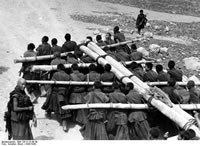
Tashilhunpo. Monks carry heavy tree trunks to be used as jogjam, building material …
BA: 135-S-15-38-39
It looks fantastic when 30 to 60 singing lamas in rows of 6 to 12 meters, dragging large stones needed for the new buildings, move one after the other, tied together in yokes, just as wild as the Sera lamas. I recently observed how they moved like a steamroller and thoughtlessly ran right over a caravan of donkeys coming toward them, without halting, the small donkeys collapsing under the weight of the heavy tree trunks, some of them even left to die from their neck injuries. The rowdies then began a regular row, ten donkeys rolled in the dust, and the roaring laughter of the lamas drowned out the curses of the caravan people who had incurred terrible damages.¹⁶³
End of the Expedition and Return to Germany
After their stay in Shigatse, the expedition ended in a hasty retreat to Sikkim when Schäfer finally realized after reading a letter from his father that, given the imminent threat of war, it would be wise to return to Germany as quickly as possible. Upon the completion of the expedition, Lord Linlithgow, Viceroy of India, received Schäfer in a private audience in Simla.¹⁶⁴ Schäfer presented the results of the expedition on 25 July 1939 at the Himalaya Club Calcutta, here recorded in his own English:
[…] I myself, besides doing the negotiations and leading the Expedition in general, worked mainly with ornithology, mammalogy and seed collecting … what follows is a rough and preliminary sketch of the results of our work in this field. As we were on a Community Expedition, with the greatest ideal of helping each other, of exchanging scientific ideas, of comradeship and mutual understanding, a common achievement was created, and therefore I will not mention in this connection the individual names of the scientists who brought about the results, but rather only the branches of sciences.
Geography:
Terrestrial magnetism, Geophysics, Surveying and similar problems:
1. 650 terrestrial magnetic stations were completed.
2. 61 absolute stations including exact measurements of all terrestrial elements, astronomical positions etc. were brought [up].
3. A large number of photogrammetric measurements for map-making including the outstanding mountain ranges in Sikkim and Tibet and exact maps of the great cities of Lhasa, Shigatse and Gyantse with their surroundings.
4. Exact meteorological measurements, including observations of clouds, the problem of the monsoon, temperatures, air pressures, humidity in all camps and places.
5. Measurements of the salt content in Tibetan and Sikkimese lakes.
6. The soundings of lakes and rivers and the rapidity of rivers.
7. Very numerous measurements of exact altitudes of all important places, all camps, all passes, all contact zones, timberlines, changes of Fauna and Flora, etc.
8. A representative collection of the minerals.
9. A good collection of petrofacts [petrified objects] found in Tibet.
10. Maps and sketches of the geological structure and stratifications of the country etc.
Anthropology and Ethnology:
11. About 400 complete anthropological measurements of Sikkimese-Bhutias, partly Lepchas, Lachenese, Lachung people and many Tibetans.
12. Hundreds of dactiloscopic hand and a certain number of foot-prints.
13. Sixteen head masks and sculptures of Lachenese, Lachung people, Nepali, Sikkimese-Bhutias and Tibetans, men, women and children.
14. Sketches of many foundations of houses and photogrammetric pictures for the purpose of reconstructing interesting buildings such as the Potala.
15. A large and nearly complete collection of ethnological objects embracing the cultures, both material and spiritual, and religions of Sikkim and Tibet. A third of the entire expenditure of the Expedition went into this collection, which came up to about 150 mule loads. The greatest trouble was also taken to obtain as many of the cheap everyday tools used in households, fields, handicrafts etc.
Botany:
16. About 2000 samples of wild flower seeds, such as Rhododendrons, Poppies, Primulas and medicinal plants were collected and shipped. All seeds of grains, fruits and vegetables, mostly primitive forms and species, which we need badly for crossbreeding with our already in many degenerate forms, were collected, numbering approximately to 4000-5000 samples, requiring up to about 10 mule loads.
18. Several hundreds, may be more than a thousand flowering plants, dried and pressed, were also brought together in herbariums.
Zoology:
19. 3500 bird skins, 2000 bird eggs, 400 mammals, a certain number of reptiles and amphibia, many thousands of butterflies, several thousands of hymenoptera, a smaller collection of orthoptera and about 150 skulls of all existing domestic animals, were collected.
Photography and Films:
20. More than 20,000 good black and white still pictures of land, people, animals, plants etc. were taken and in addition to this, about 2000 coloured still pictures. About 40,000 ft. of moving pictures, of which more than 90% came out well, were taken, and in addition to this, about 4,000 ft. of colour moving picture films …
I have just returned from Simla, where His Excellency the Viceroy kindly and most graciously granted me a farewell audience, and from Dehra Dun, where for reasons of mutual understanding and gratitude to the Government of India with the results of our surveying work, which of them, have a practical and material, but for us only a scientific and theoretical value.¹⁶⁵
From Calcutta the expedition first took a British Airways seaplane to Baghdad, which developed engine trouble and was forced to make an emergency water landing in Karachi. In Baghdad they were fortunate to be able to continue their flight to Athens on a Lufthansa JU 52. They learned a few hours later that their previous British Airways seaplane had sunk off Alexandria. A surprise awaited them in Athens, where they boarded a special new aircraft that was placed at their disposal by the German government for their safe return home.¹⁶⁶
The extensive amount of material gathered by expedition members, despite their relatively short stay in Sikkim and Tibet, is impressive, as is the way in which they used every occasion to collect as much information and learn as much as possible in order to make the most of their unique opportunity.
Points of Controversy
During the expedition’s stay in Lhasa, its status was affected to some extent by Richardson’s disapproving attitude; he was strongly opposed to Nazism. In 1936 Hugh E. Richardson (1905-2000)¹⁶⁷ was initially appointed British Trade Agent in Tibet by his superior, Basil J. Gould, Political Officer for Sikkim, with the aim of consolidating British influence against the presence of the Chinese in Lhasa. Later Richardson became head of the British Mission there.
One problem that Hugh Richardson faced, along with all the other members of the expedition, was Schäfer’s unpredictable temperament. Years later, Heinrich Harrer mentioned that a Khampa man who had worked with Schäfer for a long time shared his recollection in 1946 of how quickly Schäfer’s “blood could boil.”¹⁶⁸ The unevenness of his moods only seemed to grow worse in Lhasa,¹⁶⁹ apparently especially towards the end of the expedition, as the danger of war in Europe loomed and Schäfer grew increasingly nervous about getting back to Europe before its outbreak. The reports of other Englishmen involved also give witness to his outbursts. Yet when Gould¹⁷⁰ and Metcalfe in Sikkim later learned of Schäfer’s tragedy – his new bride had died in a hunting accident just a few months before the start of the expedition¹⁷¹ – they expressed their understanding of his moody behavior.¹⁷²
By the time the expedition was settled in Lhasa, Richardson’s many contacts had already enabled him to attain an influential position there. It is thus easy to imagine his suspicions about the contacts that developed between the Germans and influential Tibetans, and his fear of the potential disruptions in his circles these contacts might cause.¹⁷³ The competition between the British and the Germans, already highlighted by Richardson before the expedition arrived in Lhasa, evidently put the Tibetans in an uncomfortable situation.¹⁷⁴ As the competition increased, Tsarong, when interviewed by Rapten for his autobiography, was finally driven to ask “whether relations between the Germans and English really were good.” When Rapten affirmed that they were, Tsarong folded his hands, prayed, and said, “The two great nations must keep peace with each other; if there is another war between them, the world will be destroyed.”¹⁷⁵
One of Richardson’s major criticisms of the Germans was that the expedition members’ appearance and style of dress¹⁷⁶ undermined the prestige of the Europeans¹⁷⁷ in Lhasa. The Tibetans, however, appear to have had a more easy-going attitude on the issue. The report of Tsewang Pemba – only nine at the time and the only Tibetan to my knowledge who mentions the Schäfer expedition – amusingly shows this:
One day we saw a queer looking group of horsemen ride into Dekyi-Linka. The ponies were Tibetan, with Tibetan saddles of a poor quality. The riders, however, were distinctively not Tibetan! They had blond hair, blue eyes and dirty unkempt beards. Hunched over their saddles, the three of them, with a Tibetan, rode into the place. We learnt that they were Germans. I think they were probably anthropologists or entomologists of some sort. The British were always conscious of maintaining their prestige in Tibet, and wherever they went it was due to pomp and ceremony. They would not dream of putting in such a ragged appearance as these Germans.
Soon the stories about these people were the daily topic of conversation amongst the folk of Lhasa. These Germans collected lice! They were said to pay about sixpence for a louse. I must say that many of the Tibetan beggars continually harbouring cohorts of lice almost became millionaires overnight.¹⁷⁸
An event that principally Richardson exaggerated, and referred to it again and again,¹⁷⁹ occurred when Schäfer had evidently been taking photographs too openly in Lhasa in the Mönlam crowds and was hit on the head by a stone from the crowd. Sporting an outsize bandage, Schäfer dramatized the event to coerce the Tibetans into awarding him an additional permit for Shigatse to appease their consciences. The event did not seem to be too out of the ordinary,¹⁸⁰ since the Tibetans universally comforted Schäfer, saying that the same thing had happened to others. In 1937 Theos Bernard had had to flee from the stones of the crowd while taking photographs,¹⁸¹ as, allegedly, had Charles Bell, Richardson himself, and even the former Chief of Police, Laden-La.¹⁸² But the Tibetans were also susceptible to rumors,¹⁸³ as Tsewang Pemba remarked after the stone-throwing incident: “After this incident rumors started to fly about thick and fast. It was said the Germans had radioed to Germany to send heavy bombers to blast Lhasa, and for that fear … the Lhasa Government had made an official apology.”¹⁸⁴
A central criticism of the expedition, particularly from the British, was that Schäfer killed so many birds in Tibet for research. However, the expedition had brought no weapons from Sikkim to Tibet,¹⁸⁵ and Schäfer bagged all the birds with home-made slingshots, generally after dark.¹⁸⁶ Schäfer’s use of the catapult no doubt frequently hurt the feelings of the Tibetan population, particularly when he killed the birds near monasteries. And yet he was not an exception, for the British¹⁸⁷ and Tibetans also hunted, principally in Eastern Tibet.¹⁸⁸ F.M. Bailey, for example, ordered 3,000 birds to be collected in Nepal for scientific purposes.¹⁸⁹ Joseph Rock collected 1,600 bird skins for study in 1923¹⁹⁰ and over 700 in the first season of 1928,¹⁹¹ and Roy Chapman Andrews collected 800 birds in Mongolia.¹⁹² Among the Tibetans in Lhasa, Jigme Taring was particularly known for his passion for hunting, a legacy of his English upbringing and the cause of much sorrow to his wife.¹⁹³ Despite the ban on hunting in and around Lhasa, he added to Schäfer’s zoological collection without the latter needing to fire a shot.¹⁹⁴
Final Considerations – Reasons for the Expedition’s Success
Whatever the controversies and problems the Schäfer Expedition may have faced, in terms of the scientific material they collected and the way in which they served to improve relations between Germany and Tibet, the mission was a success. We may now turn to consider briefly some of the reasons for their success.
Before entering Tibet, every member of the expedition made efforts to learn Tibetan etiquette; they took with them the Sikkimese aristocrat Rapten, who also served as their interpreter and continued their instruction.
Schäfer himself must have been an excellent negotiator. He proved successful even when he complained about ill-treatment from the Tibetans. He seems to have been very much concerned with his honor, which he often connected with that of his home country. Schäfer cleverly used the swastika symbol to create the idea of an identity shared between the Germans and the Tibetans, thus linking the two nations – West and East – even on the symbolic level.
Bruno Beger, the anthropologist, had brief medical training that enabled him to treat sick members of the Tibetan aristocracy, and so expedition members were frequently invited into the houses of the nobility. Finally, the Tibetans appear simply to have enjoyed the Germans’ cheerfulness. According to Schäfer’s diaries, they were fond of the expedition members singing German songs. It is quite amusing to read about parties in Tsarong’s house, the Germans linking arms with the Tibetans and swinging from side to side, singing the most popular song from Munich’s Oktoberfest.¹⁹⁵ Heinrich Harrer also reports on the expedition in his unpublished diaries¹⁹⁶ and memoirs:
I never knew Ernst Schäfer personally, although I frequently encountered the names of the five members of his expedition when in Lhasa. They had gained great popularity. I was often called upon to translate the instructions in the numerous packages of medicines which they had left.¹⁹⁷
Notes
1. Approximately 2,000 prints have been available on the internet since 2007.
2. See Isrun Engelhardt, “Nazis of Tibet: A Twentieth Century Myth,” in Monica Esposito (ed.), Images of Tibet in the 19th and 20th Centuries. Paris: École française d'Extrême-Orient (EFEO), coll. Études thématiques 22, vol. I, 2008, 63-96.
3. Victor and Victoria Trimondi, Hitler, Buddha, Krishna: Eine unheilige Allianz vom Dritten Reich bis heute, Wien: Ueberreuter, 2002, 115–174; Christopher Hale, Himmler’s Crusade: The true story of the 1938 Nazi expedition into Tibet, London: Bantam, 2003; Heather Pringle, The Masterplan: Himmler’s Scholars and the Holocaust, London: Fourth Estate, 2006.
4. Martin Brauen, Traumwelt Tibet, Bern: Haupt, 2000, 53–81; (English translation: Dreamworld Tibet: Western Illusions, Bangkok: Weatherhill, 2004); the Master’s thesis of Mark J. Rogers, The SS-‘Ahnenerbe’ and the 1938/39 German Tibet Expedition, Atlanta: Georgia State University, M.A. Thesis, 2000, mainly contains a retelling of Ernst Schäfer, Geheimnis Tibet: Bericht der deutschen Tibet-Expedition Ernst Schäfer, Munich: F. Bruckmann, 1943; Reinhard Greve, “Tibetforschung im SS-Ahnenerbe,” in Thomas Hauschild (ed.), Lebenslust und Fremdenfurcht, Frankfurt: Suhrkamp, 1995, 168–199; Nicholas Goodrick-Clarke, Black Sun: Aryan Cults, Esoteric Nazism and the Politics of Identity, New York: New York University Press, 2002, 107–127; Goodrick-Clarke, The Occult Roots of Nazism, London: Tauris, 1992, 217–225; James Cooper, “The Swastika & Tibet,” The Tibetan Review 36, (July 2001), 19–23. In his doctoral dissertation, completed in the fall of 2003, Nationalsozialistische Expeditionspolitik: Deutsche Asien-Expeditionen 1933–1945, Munich: Herbert Utz, 2006, Peter Mierau discusses primarily those aspects of the expedition unrelated to Tibet.
5. Ernst Schäfer, Geheimnis Tibet; Schäfer, Fest der weissen Schleier: Eine Forscherfahrt durch Tibet nach Lhasa, der heiligen Stadt des Gottkönigtums, Braunschweig: Vieweg, 1949; Schäfer, Über den Himalaya ins Land der Götter, Braunschweig: Vieweg, 1950; Geer-Beger, Wir ritten nach Lhasa, based on the diary of Edmund Geer, supplemented by reports of Dr. Bruno Beger, with the assistance of Dr. Joseph Knott, member of the International Expedition Society, 1950, Murnau n.d.; Bruno Beger, Mit der deutschen Tibetexpedition Ernst Schäfer 1938/39 nach Lhasa, Wiesbaden: Dieter Schwarz, 1998.
6. Schäfer’s handwritten diaries in the Bundesarchiv (Federal Archives) Berlin, R 135/36–42 (hereafter cited as BA Berlin) were written in Sütterlin script – a kind of handwriting formerly popular among German speakers – which is difficult to decipher.
7. The standard work on the ‘Ahnenerbe’ is: Michael Kater, Das ‘Ahnenerbe’ der SS 1935–1945: Ein Beitrag zur Kulturpolitik des Dritten Reiches, 3, unveränderte Auflage mit einem Nachwort zur 2. Auflage 1997, Munich: Oldenbourg, 2001.
8. For more details about the planning of the expedition and its political dimensions, see Isrun Engelhardt, “Tibetan Triangle: German, Tibetan and British Relations in the Context of Ernst Schäfer’s Expedition, 1938–1939,” Asiatische Studien / Études Asiatiques 58, (2004), 57–113.
9. Ernst Schäfer, Berge, Buddhas, Bären, Berlin: Paul Parey, 1933, is the report on this expedition.
10. In 1934 he joined the SS, probably to advance his career and with a clear elitist attitude. The poor career prospects doubtless influenced future academics’ decision to join such political organizations. See Michael Grüttner, Studenten im Dritten Reich, Paderborn: Schöningh, 1995, 23; and also Jürgen Haffer, Erwin Stresemann, (1889–1972) – Leben und Werk eines Pioniers der wissenschaftlichen Ornithologie, Heidelberg: Barth, 2000, 143.
11. On this expedition, see Ernst Schäfer, Unbekanntes Tibet: Durch die Wildnisse Osttibets zum Dach der Erde, Tibetexpedition 1934/36, Berlin: Paul Parey, 1937; Schäfer, Dach der Erde, Berlin: Paul Parey, 1938; see also Brooke Dolan, Ernst Schäfer, and Rodolphe Meyer de Schauensee, “Zoological Results of the Second Dolan Expedition to Western China and Eastern Tibet, 1934–1936,” Proceedings of the Academy of Natural Sciences of Philadelphia 90, (1938), 159–294.
12. In his letter (Bodleian Library Oxford, MS. OR. Richardson 27, fol. 14) to Hugh Richardson, dated 10 March 1989, Robert McCracken Peck (Academy of Natural Sciences) states that thanks to Schäfer, the Museum of the Academy owns one of the world’s most comprehensive repositories of Tibetan fauna.
13. Robert McCracken Peck in “News of the Academy,” (undated copy, presumably in 1992, the year of Schäfer’s death).
14. Ernst Schäfer, “Ornithologische Ergebnisse zweier Forschungsreisen nach Tibet,” Journal für Ornithologie 86, (1938), special issue, 349 pages.
15. See Sven Hedin, German Diary, 1935–1942, Dublin: Euphorion, 1951, 122–123.
16. For an examination of these aspects of Himmler’s character, see Joachim Fest, “Die andere Utopie: Eine Studie über Himmler,” in Fremdheit und Nähe: Von der Gegenwart des Gewesenen, Stuttgart: Deutsche Verlagsanstalt, 1996, 138–166.
17. See Frank-Lothar Kroll, Utopie als Ideologie: Geschichtsdenken und politisches Handeln im Dritten Reich: Hitler – Rosenberg – Darré – Himmler – Goebbels, Paderborn: Schöningh, 1998, 210.
18. Felix Kersten, The Kersten Memoirs, 1940–1945, London: Hutchinson, 1956, 149–153.
19. Kroll, Utopie als Ideologie, 248–251.
20. Final Intelligence Report (OI-FIR/32), “The Activities of Dr. Ernst Schaefer, Tibet Explorer and Scientist with SS-Sponsored Institutes,” 12 February 1946, National Archives, Washington, RG 238, M-1270 roll 27, fol. 3.
21. Bundesarchiv (Federal Archives) Koblenz (hereafter cited as BA Koblenz), R 73/1498, fol. 87. On 6 October 1936 Schäfer submitted this slightly revised expedition plan to Himmler (BA Berlin NS 21/682).
22. “… to which I add the Northern land of Tibet, perhaps the general retreat of the human race, and its flora after our earth’s final revolution …” Immanuel Kant, Von den verschiedenen Rassen der Menschen, (Wilhelm Weischedel, ed.), Werke in sechs Bänden, vol. 6, Darmstadt: Wissenschaftliche Buchgesellschaft, 1966, 23. See also Ingo Wiwjorra, “’Ex oriente lux’ – ‘Ex septembrione lux’: Über den Widerstreit zweier Identitätsmythen,” in Achim Leube and Martin Hegewitsch (eds.), Prähistorie und Nationalsozialismus, Heidelberg: Synchron, 2002, 73–106, here: 76–77.
23. See John Fairfield Osborn in Roy Chapman Andrews, On the Trail of Ancient Man, New York: Putnams, 1926, VIII–IX; William Diller Matthew, Climate and Evolution, New York (1915), repr. New York: Arno, 1974, 41–42. See also: Gelek, “The Tibetan Plateau: One of the Homes of Early Man,” in Charles Ramble and Martin Brauen (eds.), Anthropology of Tibet and the Himalaya, Zurich: Ethnological Museum of the University of Zurich, 1993, 73–79.
24. From Sievers’s memo, 6 August 1937, BA Berlin, NS 21/682.
25. Helmut Heiber, Reichsführer! … Briefe an und von Himmler, Munich, dtv 1970.
26. “Then our suggestion of the Government Architectural Officer (Baurat) Kiss was rejected,” Sievers to Wolff, 23 January 1938, BA Berlin, NS 21/682.
27. Hörbiger’s “World Ice Theory” states that Atlantis was destroyed by a great flood that resulted when a moon of ice collided with the Earth. “Himmler believed that ancient emigrants from Atlantis had founded a great civilization in Central Asia.” Final Intelligence Report (OI-FIR/32), “The Activities of Dr. Ernst Schäfer,” fols. 3–4.
28. “Wüst should also be consulted concerning philological issues and the composition of the team, if necessary taking philological issues into consideration,” from Sievers’ memo, 20 September 1937, BA Berlin, NS 21/165.
29. BA Berlin R 135/43, fol. 163381; Beger’s research program in note form, BA Berlin, R135/43, fol. 163380; see also Greve, Tibetforschung, 173.
30. See for example J.P. Mallory, “A History of the Indo-European Problem,” The Journal of Indo-European Studies 1, (1973), 21–65; Mallory, In Search of the Indo-Europeans, London: Thames and Hudson, 1989; See also R. G. Harshe, “Mount Meru: The Homeland of the Aryans,” Vishveshvaranand Indological Journal 2, (1964), 135–161.
31. E.g. Percy T. Etherton, “Himalayas – Cradle of the Aryan Race,” in Percy T. Etherton, The Last Strongholds, London: Jarrolds, 1934, 273–284.
32. For example the articles of Paolo Francalacci, Tongmao Zhao, Han Kangxin, Harold C. Fleming, in Victor H. Mair (ed.), The Bronce Age and Early Iron Age Peoples of Eastern Central Asia, vol. 2. Washington: The Institute for the Study of Man, 1998; John V. Day, Indo-European Origins: The Anthropological Evidence Washington D.C.: The Institute for the Study of Man 2000; Spencer Wells, The Journey of Man: A Genetic Odyssey, London: Allen Lane, 2002.
33. See for example Schäfer in an undated letter to Beger from the end of December 1937: “And I set the yardstick for our coming expedition quite independently of other people or explorations … This independence awarded to me by the Reichsführer – and without which I would never have taken on the responsibility …,” BA Berlin, R 135/43 fols. 163367–163370.
34. Sievers to Wolff, 23 January 1938, BA Berlin, NS 21/682. Sievers’ memo dated 9 March 1938, BA Berlin, NS 21/165.
35. 27 May 1938, BA Berlin, NS 21/682.
36. Schäfer to Galke, 14 October 1937, BA Berlin, NS 21/682; Sievers’s memo dated 14 October 1937, BA Berlin, NS 21/165.
37. Sievers’s memo dated 9 March 1938, BA Berlin, NS 21/165.
38. Podewils to Foreign Office, Berlin, 11 June 1938, BA Berlin, ZM 1457 A.5, fols. 47–48. As a result, evidently while in Calcutta, Schäfer ordered a new, discreet letterhead in Antiqua font, which read “Deutsche Tibet Expedition Ernst Schäfer.”
39. Mentzel, President of the DFG, to Schäfer, 8 March 1938, BA Koblenz, R 73/1498 and BA Berlin, NS 21/682.
40. BA Berlin, R 135/5, fol. 150165.
41. For Himmler’s circle of friends, see Reinhard Vogelsang, Der Freundeskreis Himmler, Göttingen: Musterschmid, 1972.
42. Ernst Schäfer, Unpublished and hand-written notes at the Library of Congress (Washington D.C.), Manuscript Division, German Captured Documents, Container 828, Reel 491. The bulk of these notes on microfilm is in great disorder. Since the Library has not numbered the folios, no numbers can be given. (Hereafter cited as Library of Congress, “German Captured Documents,” Container 828, Reel 491 or 492.)
43. Gordon T. Bowles, Racial Origins of the Peoples of the Central Chinese–Tibetan Border, PhD Thesis Harvard: Cambridge, Mass., 1935.
44. R. Biasutti, “Osservazione Anthropologiche Eseguite da G. Dainelli su Cachmiri, Ladachi e Nubrese (1930),” in Giotto Dainelli, ed. Spedizione Italiana de Filippi nell’ Himalaya, Caracorùm e Turchestàn Chinese (1913–1914), Serie II, vol. 11, Bologna: Nicola Zanichelli, 1933, 193–267.
For instance, between 1951 and 54 anthropological measurements of 5000 Tibetans were taken in Kalimpong at the Tibetan border with the help of the Indian police. After 2956 measurements researchers ran in to difficulties, allegedly not from the Tibetans themselves, but ultimately from the Chinese, who suspected “that the real object of my anthropological work was to interview Tibetans, instruct them, and plant them as 'imperialist' agents in Tibet …”
Prince Peter of Greece and Denmark and J. Balslev Jørgensen:
“Physical, Anthropological Observations on 5000 Tibetans from the 3rd Danish Expedition to Central Asia.”
In: Id. et al.: Anthropological Researches from the Danish Expedition to Central Asia. (Det Kongelige Danske Videnskabernes Selskab. Historisk-filosofiske Skrifter, 4, 4)
København 1966, 2-76 and IV plates.
Ernst C. Büchi: “Zur Anthropologie der Tibetaner.” in: Bulletin der schweizerischen Gesellschaft für Anthropologie und Ethnologie 35 (1958-1959), 4-6, 95-107.
The Swiss anthropologist measured 198 Tibetans at the border of Tibet in Sikkim and North Bengal.
45. However, Beger’s anthropological measurements of prisoners in Auschwitz five years later cast the expedition in a dubious light and contributed to its controversial image. See Landgericht Frankfurt am Main, Case 4KS 1/70, Judgement 6 April 1971, appealed to Bundesgerichtshof, Case 2 StR 293/72, Judgement 22 March 1973; see also Irmtrud Wojak, “Das ‘irrende Gewissen’ der NS-Verbrecher und die deutsche Rechtssprechung: Die ‘jüdische Skelettsammlung’ am Anatomischen Institut der ‘Reichsuniversität Straßburg,’” in Jahrbuch zur Geschichte und Wirkung des Holocaust (1998/1999): 101–130; Hans-Joachim Lange, Die Namen der Nummern: Wie es gelang, die 86 Opfer eines NS-Verbrechens zu identifizieren, Munich: Hoffmann und Campe, 2005.
46. When they left, the Nazi propaganda newspaper Völkischer Beobachter had printed an article headlined: “SS Expedition Leaves for Uncharted Regions of Tibet.” An article in the Börsen Zeitung was also carefully noted. See British Library, London, Oriental and India Office Collections (Hereafter cited as OIOC) L/P&S/12/4343, fol. 333. The Indian “Statesman” immediately printed the article, but under the headline “Nazi invasion – Blackguards in India.”
47. Podewils to Foreign Office, 11 June 1938, BA Berlin, ZM 1457 A5, fol. 45.
48. See OIOC, L/P&S/12/ 4342, fol. 36; L/P&S/12/4263, fols. 51–52.
49. The Viceroy seems to have had a personal interest in Schäfer, “His Excellency the Viceroy, who is taking a personal interest in the matter,” Metcalfe to Podewils, 11 June 1938, BA Berlin, ZM 1457 A5, fol. 52.
50. Hugh Richardson soon reported: “Sikkim Durbar have agreed to permit Schäfer’s expedition subject to a reasonable limitation of collecting birds which in view of Buddhist religious scruples and of general policy of preservation of wild life seems to be quite justifiable,” Richardson to Foreign Office, 31 May 1938, OIOC, L/P&S/12/4343, fol. 275.
51. Gould to Savidge, 22 August 1938, OIOC, L/P&S/12/4343, fol. 208.
52. I cannot confirm whether he actually followed Podewils’s alleged advice, “to provoke an invitation from a neighboring Tibetan prince, thus creating a new situation for him and for us.” Since relations with Podewils were strained, this could be a retrospective justification by Podewils to demonstrate his share in the expedition’s success, as Schäfer’s relationship with the Consulate General was somewhat tense. From Foreign Office to the Head of the personal staff of the Reichsführer SS, 24 April 1939, BA Berlin, NS 19/1053, fol. 2.
53. Ernst Schäfer, Über den Himalaya ins Land der Götter, Durach: Windpferd, 1989, 8–9.
54. Gangtok in Sikkim on the 13th day of the 7th Tibetan month, Library of Congress, “German Captured Documents,” Container 828, Reel 491.
55. Richardson to Gould, 26 November 1938, OIOC, L/P&S/12/4343, fol. 188. However, Richardson stated later in a letter from 30 April 1939 to the Kashag ministers, “that the applications of Dr. Schaefer and Professor Tucci were simply forwarded to you without any recommendation from the Government of India as they had been received from the Embassies in London of Germany and Italy respectively.” (OIOC, L/P&S/12/4268).
56. Bayerische Staatsbibliothek München, Cod. tibet. 536/1; Schäfer, Geheimnis Tibet, 162–163.
57. Suydam Cutting, “In Lhasa – the Forbidden,” Natural History 37, (1936), 103–126; Cutting, The Fire Ox and Other Years, London: Collins, 1947, 173–246.
58. Theos Bernard, Land of a Thousand Buddhas: A Pilgrimage into the Heart of Tibet and the Sacred City of Lhasa, London: Rider, 1940.
59. Schäfer, Library of Congress, “German Captured Documents”, Container 828, Reell 492.
60. “Rapten Kazi had received instructions to report most minutely on all the expedition’s intentions and conversations, for we were under political suspicion, we were capable of anything and two of us would be capable of toppling Sikkim and transforming it into a German colony!” 26 December 1938, BA Berlin, R 135/38, fol. 41d.
61. BA Berlin, R 135/30/12, “Lecture to be given on the 25.7.39 by Dr. Ernst Schaefer at the Himalaya Club, Calcutta”.
62. Beger, Mit der Schäfer Expedition nach Lhasa, 20.
63. Schäfer, Unpublished Memoirs: 198: Schäfer visited Kaiser in Sikkim in 1963, who returned the gesture with a visit to Germany in 1980. In 2000 Kaiser died a highly-respected man in Sikkim. See his obituary on his extraordinary life in the Sikkim Weekend Review, 19 May 2000, 9.
64. BA Berlin, R 135/57, fol. 162 049.
65. OIOC, L/P&S/12/4343, fol. 60, Letter from the General Secretary to his Highness the Maharaja of Sikkim to the Political Officer of Sikkim, Gangtok, 16 June 1939.
66. OIOC, L/P&S/12/4343, fol. 36, Letter from Gould to Savidge, 8 July 1939.
67. See on his obituary Anna Balikci-Denjongpa, “German Akay (1915–2005),” The Bulletin of Tibetology 41 (1), (2005), 89–91.
68. BA Berlin, R 135/30/19.
69. BA Berlin, R 135/57, fol. 151 519. On the system of Pipön, see Sophie Bourdet-Sabatier, “The dzumsa (‘dzoms sa) of Lachen: An Example of a Sikkimese Political Institution,” Bulletin of Tibetology 40 (1), (2004), 93–104.
70. BA Berlin, R 135/56, fol. 165 073.
71. BA Berlin, R 135/57, fol. 151 446.
72. BA Berlin, R 135/56, fol. 165 075.
73. BA Berlin, R 135/57, fols. 151 496–151 501.
74. BA Berlin, R 135/56, fol. 165 085.
75. Paul G. Hackett, author of Theos Bernard, the White Lama: Tibet, Yoga, and American Religious Life. New York: Columbia University Press 2012, has kindlyhas kindly informed me that during his visit in Gyantse in 1937, Bernard also very much admired her and spoke of her beauty. For more on the story of Namgyal Tshedrön, who charmed others besides these five Germans, see Melvyn Goldstein, A History of Modern Tibet, 1913–1951: The Demise of the Lamaist State, Berkeley: University of California Press, 1989, 340–341, 357.
76. BA Berlin, R 135/46, fol. 164 712, 164 717.
77. According to Beger he was 26 years old and rather critical toward the strong influence of the British, BA Berlin, R 135/56, fol. 165 085.
78. BA Berlin, R 135/46, fols. 164 714–164 716.
79. BA Berlin, R 135/65, fol. 165 575.
80. BA Berlin, R 135/39, fol. 1b, 12d.
81. BA Berlin, R 135/39, fol. 20d.
82. BA Berlin, R 135/39, fols. 24d–25a.
83. BA Berlin, R 135/39, fol. 86b.
84. On Trekhang, see Luciano Petech, Aristocracy and Government, 1728–1959, Roma: IsMEO, 1973, 226. On his dismissal by Reting in August 1939, see Goldstein, A History of Modern Tibet, 337–338.
85. BA Berlin, R 135/40, fol. 8d.
86. BA Berlin, R 135/39, fol. 18a.
87. BA Berlin, R 135/39, fol. 32c. On jewels and finery sees also Dorje Yudon Yuthok, (Michael Harlin ed.), House of the Turquoise Roof, Ithaca, NY: Snow Lion, 1990, 185–200, 321–325; on patruk p. 321. Harrer, Unpublished Diaries, 1 September 1946, was apparently impressed with Pünkhang’s second wife’s decoration as well. “I am sitting together with Phünkhang, his wife and his daughter. Both of them are dressed in wonderful brocade and decorated with Tibetan jewelry. Each piece has a value of about 100,000 rupees.”
88. BA Berlin, R 135/39, fol. 5d.
89. See also Richardson: “The Regent is governed by self-interest. He has no fixed policy and his actions are dictated by momentary considerations. The misfortune of Tibet lies in the fact that although there are many officials who may disagree with some of his actions, there is no determined opposition,” in “Report on Tibetan Affairs from October 1938 to September 1939,” OIOC, L/P&S/12/4165, fol. 90b. On Reting, see also Wangchen Gelek Surkhang, “Tibet: The Critical Years (Part III). The Reting Rinpoche,” The Tibet Journal 8, (1983), 33–39.
90. Beger, Mit der Schäfer Expedition nach Lhasa, 160.
91. BA Berlin, R 135/39, fol. 1b.
92. Bayerische Staatsbibliothek München, Cod. tibet. 535 and 535 a. For more on this letter, see Isrun Engelhardt, “Mishandled Mail: The Strange Case of the Reting Regent’s Letters to Hitler,” in: Zentralasiatische Studien (ZAS) 37 (2008), 77-106.
93. F. Spencer Chapman, Lhasa the Holy City, London: Chatto and Windus, 1938, 85; David MacDonald, Twenty Years in Tibet, London: Seeley, 1932, 220; Beger, Mit der Schäfer Expedition nach Lhasa, 181.
94. OIOC L/P&S/4193, fol. 156, Lhasa Mission 1936 Diary, 24 August 1936.
95. BA Berlin, R 135/30/34, 18 April 1939.
96. On him and the other Rugby Boys, see Tsering Shakya, “Making of the Great Game Players: Tibetan Students in Britain between 1913–1917,” Tibetan Review 21, (January 1986), 9–14, 20; K. Dhondup, “The Thirteenth Dalai Lama’s Experiment in Modern Education,” The Tibet Journal, 9, (1984), 38–58.
97. BA Berlin, R 135/57, fols. 151 978–979.
98. BA Berlin, R 135/57, fol. 162 060.
99. BA Berlin, R 135/39, fol. 11a.
100. BA Berlin, R 135/39, fols. 71c–72b.
101. BA Berlin, R 135/30/31.
102. See Tsarong’s autobiography, included separately in this volume.
103. Beger, Mit der Schäfer Expedition nach Lhasa, 155–193, passim.
104. BA Berlin, R 135/39, fol. 86d; Beger, Mit der Schäfer Expedition nach Lhasa, 193; see also Alex McKay, “Swastikas, Medicine and Tibet,” Wellcome History 20, (June 2002), 10–12.
105. BA Berlin, R 135/57, fol. 162 048.
106. BA Berlin, R 135/57, fol. 151 684.
107. BA Berlin, R 135/57, fols. 151 677–151 678.
108. BA Berlin, R 135/39, fol. 59c.
109. BA Berlin, R 135/39, fol. 65c.
110. On Tashi Wanchug Phalha, see Dorje Wangdu Phalha, Genealogie, Geschichte, und Geschicke des Hauses Phalha, Rikon: Tibet-Institut, 2004, 77–79.
111. BA Berlin, R 135/39, fol. 66b. On pearl coifs see Joachim G. Karsten and Veronika Ronge: “Mu tig thug khog: A Preliminary Note on Lhasa-Tibetan Pearl Coifs (Early 18th to Mid-20th Centuries).” In: Arslan, Saadet [u.a.] [Hrsg.]: TibetanStudies: an anthology. PIATS 2006: Tibetan Studies; proceedings of the eleventh seminar of the International Association for Tibetan Studies, Königswinter 2006 / ed. by Saadet Arslan and Peter Schwieger. - Andiast: IITBS International Institute for Tibetan and Buddhist Studies, 2010, 337–362.
112. BA Berlin, R 135/39, fol. 78c; Beger, Mit der Schäfer Expedition nach Lhasa, 186–187. This copy of the Kanjur is located now in the Bayerische Staatsbibliothek München (Bavarian State Library, Munich). See Günter Grönbold, The Words of the Buddha in the Languages of the World. Munich: Bayerische Staatsbibliothek, 2005, 128–129.
113. BA Berlin, R 135/39, fols. 82a–82d.
114. According to Nicholas and Deki Rhodes, A Man of the Frontier: S.W. Laden-La: His Life and Times in Darjeeling and Tibet, Calcutta: Mira Bose, 2006, 30, they visited France, Holland, and Belgium as well as Berlin and Munich in July 1913. In a personal communication, Nicholas Rhodes says that in 1974 he saw a photo of Lungshar and Laden La in Berlin – in a “people carrier” – a long open-top bus for tourists.
115. For an even more negative impression of Kapshöpa, see Hugh Richardson, Memoirs, Oxford, Bodleian Library, MS. Or. Richardson 2, fols. 155–156, 221.
116. BA Berlin, R 135/57, fols. 162 050–162 052, 15 and 16 and 18 March 1939.
117. However, according to Who’s Who in Tibet, Calcutta 1938, p.39, he was already born in 1915 and was only a 5th rank official in 1939 and promoted to 4th rank in 1941 (Who’s Who in Tibet, 1945, 24). He had been degraded and dismissed from service on the arrest of his father in 1934, but later Lhalu Lhacham adopted him and he was reinstated as an official. Recently I was told by Tenzin T. Rampa in Madison, Wisconsin that the now 90-year-old Lhalu is still in a good health in Lhasa and even identified some officials in this book. On Lhalu Lhacham, see Hugh Richardson, Memoirs, Bodleian Library, MS. Or. Richardson 2, fol. 154, 223.
118. BA Berlin, R 135/39, fol. 54c. Cf. also Schäfer, Fest der weissen Schleier, 180.
119. BA Berlin, R 135/39, fol. 1d.
120. BA Berlin, R 135/39, fol. 38a.
121. BA Berlin, R 135/39, fol. 56a.
122. BA Berlin, R 135/39, fol. 2d.
123. BA Berlin, R 135/56, fol. 151 106.
124. BA Berlin, R 135/38, fol. 87b. Thanks to the information from Shen Weirong, we know that Chang Wei-pei, i.e. Zhang Weibai succeeded Chiang Chi-yu i.e Jiang Zhiyu in 1938 until March 1940, when he was replaced by Dr. Kung Ch’ing-tsung, ie Kong Qingzong.
125. BA Berlin, R 135/38, fols. 3c–4b.
126. BA Berlin, R 135/39, fol. 31c.
127. Dundul Namgyal Tsarong, In the Service of his Country: The Biography of Dasang Damdul Tsarong, Commander General of Tibet, Ithaca, NY: Snow Lion, 2000, 23: “When my father returned to Tibet in 1909 with His Holiness to Tibet, he brought many cameras and photographic supplies. Some of these cameras were very big and had beautifully polished wooden cases. Later, in Lhasa, Tsarong Wangchuk Gyalpo, my maternal grandfather, would instruct him in photography.” And already during the Gould Lhasa mission in 1936, “After dinner Tsarong showed 8 millimetre cinema film, which he had taken himself; he has a small electrically driven projector.” OIOC L/P&S/12/4193, Lhasa Mission 1936 Diary, 14 September 1936, fol. 163.
128. OIOC, L/P&S/12/4193, Lhasa Mission 1936 Diary, 27 January 1937, fol. 94a, “The Regent is a young monk of very advanced ideas. He takes a live interest in events outside the country, and professes a great desire to visit India. He has lately become a very keen photographer and has also asked us to give him a wireless set as New Year’s present.”
129. Delphine Gao, “The Eye of the Living Buddha, the First Photographer of Tibet,” and “Demo and Tibet’s History,” in The First Photographer of Tibet: Lopsang Jampal Loodjor Tenzin Gyatso Demo. Photographers International, (Special Issue), Taipei 39, (August 1998).
130. See below on controversial points.
131. Beger, Mit der deutschen Tibet Expedition nach Lhasa, 181.
132. Harrer, unpublished diaries, 6 February 1946, “Schäfer presented Jigme Taring with a telescope, a first-aid kit, and a book about Germany. It seems like we come across gifts from Schäfer in almost every house we visit.”
133. BA Berlin, R 135/57, fol. 162 044.
134. BA Koblenz, R 73/1498, fols. 25–26, Deutsche Forschungsgemeinschaft (DFG), “Akte Schäfer”, 19 October 1940 and 22 October 1940.
135. On the return route, just before Gyantse, when it appeared that mail had been held up again, Schäfer learned that letters and gifts he had ordered in Germany for Reting had supposedly been sent back to Germany because there was no one suitable in Gyantse to accept them and forward them on to him. BA Berlin, R 135/41, fol. 8d.
136. See on the New Year’s ceremonies, Hugh Richardson, (Michael Aris ed.), Ceremonies of the Lhasa Year, London: Serindia, 1993. Especially helpful for identifying ceremonies, persons, and terms is Joachim Karsten, “A Note on Ya sor and the Secular Festivals Following the Smon Lam Chen Mo,” in Ernst Steinkellner and Helmut Tauscher (eds.), Contributions on Tibetan Language, History and Culture, Vienna: Arbeitskreis für tibetische und buddhistische Studien Universität Wien, 1983, 117–149.
137. Schäfer, Das Fest der weissen Schleier.
138. Dundul Namgyal Tsarong, In the Service of his Country, 25.
139. BA Berlin, R 135/30/31. Cf. also Richardson, Ceremonies of the Lhasa Year, 14–18.
140. Dated to 20 February 1939, see Beger, Mit der Schäfer Expedition nach Lhasa, 177.
141. Schäfer got the tip from Albert Herrmann, Berlin, BA Berlin, R 135/39, fol. 33c.
142. BA Berlin, R 135/39, fol. 6a.
143. BA Berlin, R 135/39, fol. 32a.
144. Gould to Savidge, 5 March, 1939, OIOC, L/P&S/12/4343, fol. 168.
145. “Richardson also launched extensive intrigues against our trip to Yarlung-Phodrang and asked the Kashag why we were treated thus.” [Response of the Tibetans:] ‘We are suffering from the B.,’” BA Berlin R 135/40, fol. 10d.
146. BA Berlin R 135/40, fol. 38d.
147. BA Berlin R 135/ 56, fol. 165 113.
148. Tibetan spellings include: yum bu lha khang, yum bu bla mkhar, yum bu bla sgang, yum bu bla rgang. See Erik Haarh, The Yar-lung Dynasty, Copenhagen: Gad, 1969, passim.
149. Bayerische Staatsbibliothek Munich, Ana 527, D. I.c. 4, “Nachlass Prof. Dr. Helmut Hoffmann.”
150. BA Berlin R, 135/56, fol. 165 117.
151. BA Berlin, R 135/40, fols. 34b–34c. See also Guiseppe Tucci, To Lhasa and Beyond, Rome: Libreria dello Stato, 1956, 144, who mentions only the Sakya temple.
152. BA Berlin, R 135/40, fols. 39a–39b.
153. BA Berlin, R 135/56, fol. 165 121; R 135/57, fol. 151 465.
154. For the difficulties concerning the correct transliteration, see Alfonsa Ferrari, Mk’yen Brtse’s Guide to the Holy Places of Central Tibet, Rome: IsMEO, 1948, 134.
155. BA Berlin, R 135/40, fol. 41d.
156. BA Berlin, R 135/56, fol. 165 123.
157. BA Berlin R 135/ 56, fol. 165 115. Parkhang died the same year. See Petech, Aristocracy and Government, 225.
158. BA Berlin, R 135/40, fols. 65b–66b.
159. Schäfer, Geheimnis Tibet, 182–183.
160. She was wearing a headdress from Tsang, a pagor. The frames were made only in larger towns in Tsang and would be taken to the bazaar, where women would buy and sew red material on them. Depending on the wealth of the woman’s family, she might also sew many decorative stones onto the red material. The whole thing would then be attached to her head with her innumerable braids. BA Berlin, R 135/57, fol. 151 418.
161. BA Berlin, R 135/40, fols. 69d–70b.
162. BA Berlin, R 135/41, fols. 17c–18a.
163. BA Berlin, R 135/41, fols. 22d–23a.
164. “I take the liberty of expressing to your Excellency my most sincere thanks for your great kindness in granting me an interview and interesting yourself in the various points to be cleared up,” Schäfer to Linlithgow, 21 July 1939, OIOC, L/P&S/12/4343, fol. 28.
165. “Lecture to be given on the 25.7.1939 by Dr. Ernst Schaefer at the Himalaya Club, Calcutta.” BA Berlin, R 135/30/12. In the Himalayan Journal 12, (1940), 153, we find the following brief comment: “On the 25th July Dr. Schaefer gave a very interesting lecture on the work done by himself and his scientists in Sikkim and Tibet.”
166. Schäfer, Unpublished Memoirs.
167. On Richardson see Claire Freeman in Clare Harris and Tsering Shakya (eds.), Seeing Lhasa: British Depictions of the Tibetan Capital 1936–1947, Chicago: Serindia, 2003, 148–151.
168. Heinrich Harrer: Unpublished Memoirs, 17 May 1946.
169. OIOC, L/P&S/12/4343, fol. 44, H.A.F. Metcalfe, 18 July 1939. “Notes on a conversation with Dr. Schaefer … He explained that although a recent convert to Nazism, he was not particularly enthusiastic about the present development and he expressed enthusiasm partly ‘to get a rise’ out of Mr. Richardson, who had rather annoyed him on more than one occasion.”
170. L/P&S/12/4343, fols. 99–100, 2 June 1939, Gould to Savidge, Camp Yatung, “Other matters which go to his personal make up are what appears to be a tendency – quite a common one amongst European – to become nervy if he lives for long at a considerable height; a proclivity to become flustered when things threaten not to go right; and his own great personal tragedy which was the cause I have been told of his sud denly being sent by Himmler on his present expedition more than a year ago.”
171. Beger, Mit der Schäfer Expedition nach Lhasa, 43, reports that there were times during the expedition when Schäfer suffered from such depression that, even while hunting rare animals in Sikkim, he was so distracted that he forgot critical preparations, injured himself, and luckily escaped a serious accident.
172. OIOC, L/P&S/12/4343, fol. 46. Metcalfe, 18 July 1939: “My general impression of him was, as before, that he is ingeniously interested in science more than politics, that he is excitable and possibly at times unbalanced, but that he is anxious to be on good terms with us and is grateful for the assistance given to him.”
173. BA Berlin, R 135/41 fol. 19c, Schäfer, “As we pulled into Lhasa and Richardson had passed us, the ‘bigwigs’ of Lhasa were all talking about how odd it was that the Germans and the British didn’t meet, there must be some major tension. They are of the opinion that R. himself has engaged in intrigues against us with all the cabinet members.”
174. Schäfer repeatedly claims that they had better seats at events, BA Berlin, R 135/39, fol. 50a, 50d, 56a.
175. BA Berlin, R 135/39, fol. 74b.
176. On the important role of prestige for the British officials in Tibet, see Alex McKay, Tibet and the British Raj: The Frontier Cadre 1904–1947, Richmond, Surrey: Curzon, 1997, 143–147.
177. Their beards were a particular cause of irritation to Richardson, so he advised all later travelers to shave because the Germans had created the impression that any man with a beard was a godless German or a Russian, Bodleian Library, MS. OR. Richardson 2, fol. 94.
178. Tsewang Pemba, Young Days in Tibet, London: Cape, 1957, 125–126. There are only some brief notes on Schäfer in Tharchin’s Tibetan newspaper, “Tibet Mirror”: X, 4, 21 Dec. 1938; X,7, 5 May 1939; X, 8, 18 June 1939.
179. OIOC, L/P&S/12, 4165, fol. 93v; Bodleian Library, MS. Or. Richardson 2, fol. 98; MS. Or. Richardson 27, fol. 6.
180. Nine days prior to the stone throwing incident, Schäfer had written in his diary that he had already been warned that in previous years, Richardson and Bernard had had to flee from rock-throwing monks. BA Berlin, R135/39, fol. 76d.
181. Bernard, Land of a Thousand Buddhas, 210–211.
182. BA Berlin, R135/39, fols. 76d, 91a–91c; see also Cutting, The Fire Ox and Other Years, 232.
183. Bodleian Library, MS. Or. Richardson 3, fol. 168.
184. Tsewang Pemba, Young Days in Tibet, 126.
185. Schäfer, Unpublished Memoirs. This is also indicated by the fact that Richardson darkened with rage when Schäfer told him that he had even received a pistol as a gift from a Tibetan official in Gyantse, BA Berlin, R135/40, fol. 8b.
186. The following also alludes to this: “After crossing the Gurka-la, one evening we saw hundreds of pheasants, and after a long debate with our great lama general he agreed to a carbine ball, with which Geer shot one of the birds. […] It is now the month of Gautama Buddha’s birth, and I was even obliged to desist from using the catapult, although by now I have almost everything and am specializing in breeding biology,” Schäfer to Stresemann, Gyantse, June 6, 1939, Staatsbibliothek Berlin, Preußischer Kulturbesitz, Nachlass Erwin Stresemann, (Nachlass 150), Ordner 57, II. (Hereafter cited as Nachlass Stresemann; BA Berlin, R 135/40, fol. 15c.
187. Alex McKay, “The Other ‘Great Game’: Politics and Sport in Tibet, 1904–1947,” The International Journal of the History of Sport 11, (1994), 372–386.
188. Toni Huber, “Traditional Environmental Protectionism in Tibet Reconsidered,” The Tibet Journal 16, (1991), 63–77; Huber, “The Chase and the Dharma: The Legal Protection of Wild Animals in Pre-modern Tibet,” in John Knight (ed.), Wildlife in Asia: Cultural Perspectives, London: Curzon, 2004, 36–65; Huber, “‘Territorial Sealing’ (rgya sdom-pa): A Religio-Political Practice in Tibet,” in PIATS 1998: Tibetan Studies: Proceedings of the Eighth Seminar of the International Association for Tibetan Studies, Bloomington, Indiana (forthcoming).
189. Stresemann to Schäfer, 3 June 1938, Nachlass Stresemann II.
190. S. B. Sutton, In China’s Border Provinces: The Turbulent Career of Joseph Rock, Botanist Explorer, New York: Hasting House, 1974, 19.
191. Sutton, In China’s Border Provinces: 190. See also Suydam Cutting on Herbert Stevens having collected 1150 birds and small mammals, Cutting The Fire Ox and Other Years, 148.
192. Charles Gallenkamp, Dragon Hunter: Roy Chapman Andrews and the Central Asiatic Expeditions. New York: Viking, 2001, 69.
193. Rinchen Dolma Taring, Daughter of Tibet, London: John Murray, 1970, 99–101.
194. Schäfer, Unpublished Memoirs.
195. BA Berlin, R 135/39, fol. 11b.
196. Heinrich Harrer, Unpublished Diaries, 6 February, 14 March, 31 May, and 6 September 1946.
197. Heinrich Harrer, Mein Leben, Berlin: Ullstein, 2002, 204. He expressly confirmed this in an interview with Roger Croston on 7 May 2003.
Select Bibliography
Anonymous (1938), Who’s Who in Tibet, Calcutta: Government of India Press.
Anonymous (1945), Who’s Who in Tibet, Calcutta: Government of India Press.
Asad, Talal (ed.) (1973), Anthropology and the Colonial Encounter, London: Ithaca Press.
Beger, Bruno (1998), Mit der deutschen Tibetexpedition Ernst Schäfer 1938/39 nach Lhasa, Wiesbaden: Dieter Schwarz.
Bell, Charles (1928), The People of Tibet, Oxford: Clarendon Press.
___ (1931), The Religion of Tibet, Oxford: Clarendon Press.
___ (1946), Portrait of the Dalai Lama, London: Collins.
Bernard, Theos (1940), Land of a Thousand Buddhas: A Pilgrimage into the Heart of Tibet and the Sacred City of Lhasa, London: Ridder.
Brauen, Martin (2004), Dreamworld Tibet: Western Illusions, Bangkok: Weatherhill.
Brody, Hugh (1998), “The Power of Image,” in J.H.C. King and Henrietta Lidchi (eds.), Imagining the Arctic, London: The British Museum, 226–227.
Chapman, F. Spencer (1938), Lhasa, the Holy City, London: Chatto and Windus.
Clark, Leonard (1955), The Marching Wind, London: Hutchinson.
Clarke, John (1997), Tibet: Caught in Time, Reading: Garnett.
Cutting, Suydam (1936), “In Lhasa – the Forbidden,” Natural History 37, 103–126.
___ (1947), The Fire Ox and Other Years, London: Collins.
Das, Sarat Chandra (1902), Journey to Lhasa and Central Tibet, (W.W. Rockhill ed.), London: John Murray.
Dhondup, K. (1984), “The Thirteenth Dalai Lama’s Experiment in Modern Education,” The Tibet Journal 9, 38–58.
___ (1986), The Water-Bird and Other Years, Delhi: Rangwang Publishers.
Dolan, Brooke , Ernst Schäfer, and Rodolphe Meyer de Schauensee (1938), “Zoological Results of the Second Dolan Expedition to Western China and Eastern Tibet, 1934–1936,” Proceedings of the Academy of Natural Sciences of Philadelphia 90, 159–294.
Don-grub Dbang-rgyal (1991), “Mgo-log lo-rgyus deb-ther”, in Mgo-log rig-gnas lo-rgyus, vol. I, (Xining?), 1–178.
Edwards, Elizabeth (ed.) (1992), Anthropology and Photography 1860–1920, New Haven and London: Yale University Press.
Ekvall, Robert B. (1952), Tibetan Sky Lines, New York: Farrar, Strauss and Young.
Engelhardt, Isrun (2004), “Tibetan Triangle: German, Tibetan and British Relations in the Context of Ernst Schäfer’s Expedition, 1938–1939,” Asiatische Studien / Études Asiatiques 58, 57–113.
Engelhardt, Isrun, “Mishandled Mail: The Strange Case of the Reting Regent’s Letters to Hitler,” in: Zentralasiatische Studien (ZAS) 37 (2008), 77-106.
Engelhardt, Isrun, “Nazis of Tibet: A Twentieth Century Myth,” in Monica Esposito (ed.), Images of Tibet in the 19th and 20th Centuries. Paris: École française d'Extrême-Orient (EFEO), coll. Études thématiques 22, vol. I, 2008, 63-96.
Ferrari, Alfonsa (1948), Mk’yen Brtse’s Guide to the Holy Places of Central Tibet, Rome: IsMEO.
Filchner, Wilhelm (1938), Bismillah, Leipzig: Brockhaus.
Gao, Delphine (1998), “The Eye of the Living Buddha, the First Photographer of Tibet,” and “Demo and Tibet’s History,” in The First Photographer of Tibet: Lopsang Jampal Loodjor Tenzin Gyatso Demo. Photographers International (Special Issue) 39, Taipei (August).
Geer-Beger (n.d.), Wir ritten nach Lhasa. Based on the diary of Edmund Geer, supplemented by reports of Dr. Bruno Beger, with the assistance of Dr. Joseph Knott, member of the International Expedition Society 1950, Murnau: Lux Lesebogen.
Goldstein, Melvyn (1989), A History of Modern Tibet, 1913–1951: The Demise of the Lamaist State, Berkeley: University of California Press.
Gosden, Chris and Chantal Knowles (2001), Collecting Colonialism: Material Culture and Colonial Change, Oxford: Berg.
Greve, Reinhard (1995), “Tibetforschung im SS-Ahnenerbe,” in Thomas Hauschild (ed.), Lebenslust und Fremdenfurcht. Frankfurt: Suhrkamp, 168–199.
Grieder, Peter (2000), Tibet, Land zwischen Himmel und Erde, Düsseldorf: Patmos.
Grönbold, Günter (2005), The Words of the Buddha in the Languages of the World, Munich: Bayerische Staatsbibliothek 2005.
Guibaut, André (1948), Tibetan Venture: In the Country of the Ngolo-Setas, London: John Murray.
Hackett, Paul (2012), Theos Bernard, the White Lama: Tibet, Yoga, and American Religious Life. New York: Columbia University Press 2012.
Harrer, Heinrich (1953), Seven Years in Tibet, London: Rupert Hart Davies.
___ (1991), Tibet: Zeitdokumente aus den Jahren 1944–1951, Zurich: Offizin.
___ (1992), Lost Lhasa: Heinrich Harrer’s Tibet, New York: Abrams.
___ (2002), Mein Leben, Berlin: Ullstein.
Harris, Clare and Tsering Shakya (eds.) (2003), Seeing Lhasa: British Depictions of the Tibetan Capital 1936–1947, Chicago: Serindia.
Harris, Clare (2003), “Seeing Lhasa: British Photographic and Filmic Engagements with the Tibetan Capital,” in Clare Harris and Tsering Shakya (eds.), Seeing Lhasa: British Depictions of the Tibetan Capital 1936 –1947, Chicago: Serindia, 1–76.
Heller, Amy (1997), “Notes on the Symbol of the Scorpion in Tibet,” in Samten Karmay and Philippe Sagant (eds.), Les habitants du Toit du monde, Nanterre: Société d’ethnologie, 283–297.
Huber, Toni (2004), “The Chase and the Dharma: The Legal Protection of Wild Animals in Pre-modern Tibet,” in John Knight (ed.), Wildlife in Asia: Cultural Perspectives, London: Curzon, 36–65.
Huc, Evariste-Régis and Gabet, Joseph (reprint 1987), Travels in Tartary, Thibet and China, 1844–1846, New York: Dover.
Karsten, Joachim (1983), “A Note on Ya sor and the Secular Festivals Following the Smon Lam Chen Mo,” in Ernst Steinkellner and Helmut Tauscher (eds.), Contributions on Tibetan Language, History and Culture, Vienna: Arbeitskreis für tibetische und buddhistische Studien Universität Wien, 117–149.
Karsten, Joachim and Ronge, Veronika (2010): “Mu tig thug khog: A Preliminary Note on Lhasa-Tibetan Pearl Coifs (Early 18th to Mid-20th Centuries).” In: Arslan, Saadet [u.a.] [Hrsg.]: TibetanStudies: an anthology. PIATS 2006: Tibetan Studies; proceedings of the eleventh seminar of the International Association for Tibetan Studies, Königswinter 2006 / ed. by Saadet Arslan and Peter Schwieger. - Andiast: IITBS International Institute for Tibetan and Buddhist Studies, 337–362.
Kozloff, P. K. (1908), “Through Eastern Tibet and Kam,” The Geographical Journal 31/5, 522–534.
LaRocca, Donald J. (ed.) (2006), Warriors of the Himalayas: Rediscovering the Arms and Armor of Tibet, New York: The Metropolitan Museum of Art.
Lhalungpa, Lobsang P. (1983), Tibet: The Sacred Realm, Photographs 1880–1950, New York: Aperture.
Macdonald, David (1932), Twenty Years in Tibet, London: Seeley.
McKay, Alex (1994), “The Other ‘Great Game’: Politics and Sport in Tibet, 1904–1947,” The International Journal of the History of Sport 11, 372–386.
___ (1997), Tibet and the British Raj: The Frontier Cadre 1904–1947, Richmond, Surrey: Curzon.
___ (2002), “Swastikas, Medicine and Tibet,” Wellcome History 20, 10–12.
Mele, Pietro Francesco (1975), Tibet, Calcutta: Oxord & IBH Publishing.
Müller, Claudius C. and Walter Raunig (eds.) (1983), Der Weg zum Dach der Welt, Innsbruck: Pinguin.
Müller, Claudius (2002), “Die Ainu in historischen Photographien – ein Porträt von außen,” in Claudius Müller (ed.), Die Ainu – Porträt einer Kultur im Norden Japans, Munich: Staatliches Museum für Völkerkunde, 90–113.
Norbu, Jamyang (2005), “Newspeak and New Tibet: The Myth of China’s Modernization of Tibet and the Tibetan Language,” in www.tibet.ca/en/wtnarchive/2005/6/16._1.html.
[www.phayul.com/news/article.aspx?id=10009&t=1
www.tibetwrites.org/?Newspeak-New-Tibet-Part-II
www.tibetwrites.org/?Newspeak-New-Tibet-Part-III
www.tibetwrites.org/?Newspeak-New-Tibet-Part-IV
www.tibetwrites.org/?Newspeak-New-Tibet-Part-V]
___ (2005), “‘NEUSPRECH’ und das Neue Tibet: Der Mythos von der Modernisierung Tibets und der tibetischen Sprache durch China,” Tibet-Forum, 66–96.
Norbu, Namkhai (1997), Journey among the Tibetan Nomads: An Account of a Remote Civilization, Dharamsala: Library of Tibetan Works and Archives.
O’Hanlon, Michael and Robert L. Welsch, (eds.) (2000), Hunting the Gatherers: Ethnographic Collectors, Agents and Agency in Melanesia, 1870s–1930s, Oxford and New York: Berghahn.
Pemba, Tsewang (1957), Young Days in Tibet, London: Cape.
Penny, H. Glenn (2002), Objects of Culture: Ethnology and Ethnographic Museums in Imperial Germany, Chapel Hill and London: University of North Carolina Press.
Petech, Luciano (1973), Aristocracy and Government, 1728–1959, Rome: IsMEO.
Phalha, Dorje Wangdu (2004), Genealogie, Geschichte, und Geschicke des Hauses Phalha, Rikon: Tibet-Institut.
Richardson, Hugh (1993), Ceremonies of the Lhasa Year, (Michael Aris ed.), London: Serindia.
Rigzin, Tsepak (1993), Festivals of Tibet, Dharamsala: Library of Tibetan Works and Archives.
Rhodes, Nicholas & Deki Rhodes (2006), A Man of the Frontier: S.W. Laden-La: His Life and Times in Darjeeling and Tibet, Calcutta: Mira Bose.
Rock, Joseph Francis (1956), The Amnye Ma-chhen Range and Adjacent Regions, Rome: IsMEO.
Rogers, Mark J. (2000), The SS-Ahnenerbe and the 1938/39 German-Tibet Expedition, Atlanta: Georgia State University, M.A. thesis.
Ronge, Veronika (1983), “Das Handwerkertum in Tibet,” in Claudius C. Müller and Walter Raunig (eds.), Der Weg zum Dach der Welt, Innsbruck: Pinguin, 153–201.
___ (2005), “Wo stehen die Frauen im tibetischen Handwerk?” Zentralasiatische Studien 34, 231–268.
Schäfer, Ernst (1933), Berge, Buddhas, Bären, Berlin: Paul Parey.
___ (1937), Unbekanntes Tibet: Durch die Wildnisse Osttibets zum Dach der Erde, Tibetexpedition 1934/36, Berlin: Paul Parey.
___ (1938), Dach der Erde: Durch das Wunderland Hochtibet, Berlin: Paul Parey.
___ (1938), “Ornithologische Ergebnisse zweier Forschungsreisen nach Tibet,” Journal für Ornithologie, 86, Sonderheft.
___ (1943), Geheimnis Tibet: Bericht der deutschen Tibet-Expedition Ernst Schäfer, Munich: F. Bruckmann.
___ (1949), Fest der weissen Schleier: Eine Forscherfahrt durch Tibet nach Lhasa, der heiligen Stadt des Gottkönigtums, Braunschweig: Vieweg.
___ (1950), Über den Himalaya ins Land der Götter, Braunschweig: Vieweg.
___ (1952), Unter Räubern in Tibet, Braunschweig: Vieweg.
Shakya, Tsering (1986), “Making of the Great Game Players: Tibetan Students in Britain between 1913–1917,” Tibetan Review 21 (January), 9–14, 20.
___ (2003), “Cities and Thrones and Powers: The British and the Tibetans in Lhasa, 1936–1947,” in Clare Harris and Tsering Shakya (eds.), Seeing Lhasa: British Depictions of the Tibetan Capital 1936–1947, Chicago: Serindia, 79–125.
Stocking, George W. (ed.) (1996), Volksgeist as Method and Ethic: Essays on Boasian Ethnography and the German Anthropological Tradition, Madison and London: University of Wisconsin Press.
Surkhang, Wangchen Gelek (1983), “Tibet: The Critical Years (Part III). The Reting Rinpoche,” The Tibet Journal 8, 33–39.
Tafel, Albert (1914), Meine Tibetreise: Eine Studienfahrt durch das nordwestliche China und durch die innere Mongolei in das östliche Tibet, vol. I. Stuttgart: Union Deutsche Verlagsanstalt.
Taring, Rinchen Dolma (1970), Daughter of Tibet, London: John Murray.
Theye, Thomas (ed.) (1989), Der geraubte Schatten: Die Photographie als ethnographisches Dokument, Munich: C. J. Bucher.
Tsarong, Dundul Namgyal (1995), Le Tibet tel qu’il était. What Tibet was, Fontenay sous Bois: Anako.
___ (2000), In the Service of his Country: The Biography of Dasang Damdul Tsarong, Commander General of Tibet, Ithaca, NY: Snow Lion.
Tucci, Guiseppe (1956), To Lhasa and Beyond, Rome: Libreria dello Stato.
___ (1973), Transhimalaya, Geneva: Nagel.
Tung, Rosemary Jones (1980), A Portrait of Lost Tibet, New York: Holt, Rinehart and Winston.
Walravens, Hartmut (ed.) 2003, Joseph Franz Rock. Expedition zum Amnye Machhen in Südwest-China im Jahre 1926, Wiesbaden: Harrassowitz.
Yuthok, Dorje Yudon (1990), House of the Turquoise Roof, (Michael Harlin ed.), Ithaca, NY: Snow Lion.



